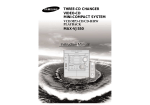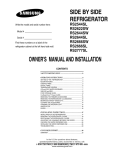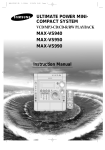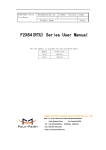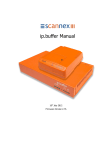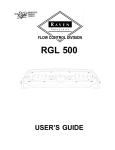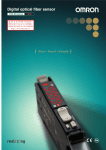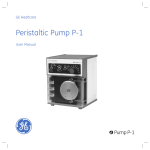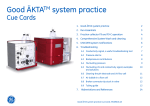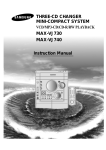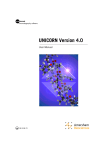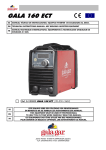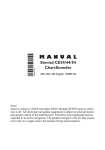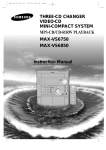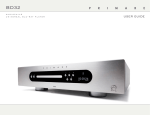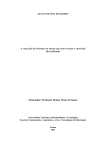Download B - GE Healthcare Life Sciences
Transcript
GE Healthcare ÄKTATM design Monitor UPC-900 User Manual Important user information All users must read this entire manual to fully understand the safe use of ÄKTA™ monitor UPC-900 Workstation. WARNING! The WARNING! sign highlights instructions that must be followed to avoid personal injury. It is important not to proceed until all stated conditions are met and clearly understood. WARNING! Read the instruction to avoid hazardous conditions. CAUTION! The Caution! sign highlights instructions that must be followed to avoid damage to the product or other equipment. It is important not to proceed until all stated conditions are met and clearly understood. Note The Note sign is used to indicate information important for trouble-free and optimal use of the product. CE Certifying This product meets the requirements of applicable CE-directives. A copy of the corresponding Declaration of Conformity is available on request. The CE symbol and corresponding declaration of conformity, is valid for the instrument when it is: – used as a stand-alone unit, or – connected to other CE-marked GE Healthcare instruments, or – connected to other products recommended or described in this manual, and – used in the same state as it was delivered from GE Healthcare except for alterations described in this manual. Recycling This symbol indicates that the waste of electrical and electronic equipment must not be disposed as unsorted municipal waste and must be collected separately. Please contact an authorized representative of the manufacturer for information concerning the decommissioning of equipment. WARNING! This is a Class A product. In a domestic environment this product may cause radio interference in which case the user may be required to take adequate measures. Contents Contents 1 Introduction 1.1 1.2 General......................................................................................................... 1 Safety............................................................................................................ 2 2 Installation 2.1 2.2 2.3 2.4 2.5 2.6 2.7 2.8 2.9 2.10 Unpacking................................................................................................... 3 General precautions............................................................................... 3 Installing the optical unit..................................................................... 4 Installing the conductivity flow cell................................................ 6 Installing the pH flow cell and electrode...................................... 6 Connecting electrical signal cables................................................ 8 Connecting to a communication link............................................. 8 Connecting to supply voltage............................................................ 9 Preparing the module for use............................................................ 9 Installing optical filters (optional)...................................................10 3 Operation 3.1 3.2 3.3 3.4 3.5 3.6 3.7 3.8 3.9 3.10 3.11 3.12 3.13 3.14 3.15 On/off..........................................................................................................11 Menu selection and settings............................................................11 Main menu overview...........................................................................13 Controlling the UV lamp.....................................................................13 Reading the UV absorbance value...............................................14 Autozeroing UV.......................................................................................14 Creating eventmarks...........................................................................14 Setting Cond, pH and UV analogue outputs............................14 Calibrating conductivity.....................................................................16 Calibrating the pH electrode............................................................16 Filtering noise in the UV signal........................................................19 Changing UV flow cell.........................................................................19 Reading pH, temperature and conductivity values..............20 Storage and shut-down.....................................................................20 Restart after power failure................................................................21 Monitor UPC-900 User Manual 18-1125-55 Edition AG V Contents 4 Maintenance 4.1 4.2 4.3 4.4 4.5 4.6 4.7 4.8 4.9 4.10 Periodic maintenance.........................................................................22 Cleaning and checking the module..............................................22 Cleaning the UV flow cell in-place................................................23 Cleaning the UV flow cell off-line...................................................23 Cleaning the conductivity flow cell in-place.............................24 Cleaning the conductivity flow cell off-line...............................24 Changing the conductivity flow cell.............................................24 Cleaning the pH electrode................................................................25 Changing the pH electrode...............................................................26 Recycling....................................................................................................26 5 Trouble-shooting 5.1 5.2 5.3 5.4 General.......................................................................................................27 Recycling....................................................................................................26 Faults and actions.................................................................................27 Error messages.......................................................................................31 Reference information A Description................................................................................................34 A.1 Module..........................................................................................34 A.2 UV optical unit..........................................................................35 A.3 pH electrode..............................................................................36 A.4 Condcutivity cell.......................................................................36 B Menu............................................................................................................37 B.1 Check menus.............................................................................37 B.1.1 Checking autozero level.........................................37 B.1.2 Checking lamp run time.........................................37 B.1.3 Checking lamp intensity.........................................37 B.1.4 Checking recorder.....................................................37 B.1.5 Checking service mode..........................................37 VI Monitor UPC-900 User Manual 18-1125-55 Edition AG Contents B.2 Setup menus..............................................................................38 B.2.1 Selecting setup sub menus..................................38 B.2.2 Setup adjust temperature.....................................38 B.2.3 Setup show temperature.......................................39 B.2.4 Setup conductivity temperature compensation.............................................................39 B.2.5 Setup conductivity reference temperature..39 B.2.6 Setup adjust conductivity......................................39 B.2.7 Setup adjust cell constant....................................41 B.2.8 Setup show conductivity.......................................41 B.2.9 Setup pH temperature compensation............42 B.2.10Setup show pH...........................................................42 B.2.11Setup UV averaging filter constant..................42 B.2.12Setup lamp run time................................................43 B.2.13Setup show UV...........................................................43 B.2.14Setup language..........................................................43 B.2.15Setup unit number....................................................44 B.2.16Setup display angle..................................................44 B.3 Setting and using the alarm timer..................................45 B.4 Service displays........................................................................45 B.5 Menu overview................................................................. 46-47 C Technical specifications.....................................................................48 C.1 Operating data.........................................................................48 C.2 Physical data.............................................................................49 D Accessories and Consumables.......................................................51 Short instructions..................................................................................57 About this manual This manual comprises two parts; a practical part (sections 1 – 5) and a reference part (sections A – D). Sections 1 – 5 contain the necessary information for operating the instrument. Monitor UPC-900 User Manual 18-1125-55 Edition AG VII 1 Introduction 1 Introduction 1.1 General Monitor UPC-900 is a high precision on-line monitor for the combined measurement of UV absorption, pH and conductivity in liquid chromatography. The UPC-900 features: • Fixed wavelengths of 254, 280 nm (Hg lamp), or 214 nm (Zn lamp). • Other wavelengths of 313, 365, 405, 436 and 546 nm through filter change. • Two alternative flow cells with pathlengths of 2 mm and 5 mm. • Fast response • High accuracy and reproducibility • Flow cells with low dead volume • Accurate and reliable monitoring through self-test and self-calibration • Flow cells can be connected close together, minimising band broadening and time delay between detectors. The monitor and the flow cells are separate units. All flow cells are connected to the rear of Monitor UPC-900. Monitor UPC-900 User Manual 18-1125-55 Edition AG 1 1 Introduction 1.2 Safety IMPORTANT! Monitor UPC-900 is intended for laboratory use only, not for clinical or in vitro use, or for diagnostic purposes. • The module is designed for indoor use only. • Do not use in a dusty atmosphere or close to spraying water. • Operate in accordance with local safety instructions. WARNING! The module must be connected to a grounded mains socket. WARNING! Always disconnect the power supply before attempting to replace any item on the module during maintenance. WARNING! The module must not be opened by the user. It contains high voltage circuits that can deliver a lethal electric shock. WARNING! When lamp power is on, the lamp socket carries a dangerous voltage. Do not connect/disconnect with the monitor switched on. WARNING! The module uses high intensity ultra-violet light. Do not remove the UV lamp while the monitor is running. Before changing a UV lamp, ensure that the lamp cable is disconnected from the monitor to prevent injury to eyes. If the mercury lamp is broken, make sure that all mercury is removed and disposed of according to national and local environmental regulations. WARNING! When using hazardous chemicals, all suitable protective measures, such as protective glasses, must be taken. WARNING! HCl and NaOH are injurious to health. Avoid spillage. WARNING! Hg lamps contain small amounts of mercury and must be handled with care and disposed of according to national or local environmental regulations. WARNING! When using hazardous chemicals, take all suitable protective measures, such as wearing protective glasses and gloves resistant to the chemicals used. Follow local regulations and instructions for safe operation and maintenance of the system. 2 Monitor UPC-900 User Manual 18-1125-55 Edition AG 2 Installation 2 Installation 2.1 Unpacking Unpack the module and check the items against the supplied packing list. Inspect the items for obvious damage that may have occurred during transportation. Note: It is important that the filters, flow cells and lamps are not handled during unpacking. For protection of these items, they should remain in their packing materials until required for use. We recommend that all packing materials be retained if onward transport of the module is expected. Note: pH measurement is optional in ÄKTA design. CAUTION! Read the following information carefully to ensure that the module is installed correctly. 2.2 General precautions The module should be located in a place of low temperature variations, away from heat sources, draughts and direct sunlight. The module may be operated at normal ambient temperatures in the range 4 to 40 °C. The module should be installed on a stable laboratory bench or in ÄKTA design system rack. To ensure correct ventilation, a free space of 0.1 m is required behind and in front of the module. Do not place soft material under the module to ensure that the ventilation inlet below the front is not blocked. UPC-900 Monitor UPC-900 User Manual 18-1125-55 Edition AG 3 2 Installation UPC-900 Holder 2.3 Installing the optical unit Installing the holder Optical unit Conductivity cell 1 Hook the holder into the slot on the right hand side of the module. Secure it by pushing up the slide clamp. Flow cell installation Protective plug for flow cell There is one analytical (5 mm) and one preparative (2 mm) flow cell available (stand-alone units only include the preparative flow cell). Both cells are installed in the same way, as described below: 2 mm 1 Remove the red protective plugs from the detector housing and the flow cell. 5 mm 2 Insert the flow cell into the detector housing from above. O-ring Note: The flow cell can only be placed in one correct position. 3 Secure the flow cell by turning the locking nut until the stop position. Note: If the locking nut is not tightened sufficiently, the monitor will function poorly (e.g. drifting base-line). 4 Place the protective cover around the flow cell to protect the electronics inside the optical unit from liquid spillage. Detector housing Note: Avoid spillage for prolonged monitor lifetime. Locking nut 5 To remove the flow cell, reverse the procedure. Note: Ensure that the Hg lamp position and the filter is selected according to the wave length to be used. This is described in the Changing lamp assembly section below. Connecting the optical unit to the module Screw Holder 1 Place the optical unit in the holder, or in a suitable location as close to the column as possible. The optical unit can be placed up to 1.5 m from the monitor housing. Optical unit 2 Secure it by tightening the screw in the holder. 3 Connect the lamp cable to the socket Lamp on the rear panel of the module. 4 Connect the signal cable to the socket Optical unit on the rear panel of the module. 4 Monitor UPC-900 User Manual 18-1125-55 Edition AG 2 Installation Changing lamp assembly WARNING! The module uses high intensity ultra-violet light. Do not remove the UV lamp while the monitor is running. Before changing a defective lamp, ensure that the lamp cable is disconnected from the monitor to prevent injury to eyes. If the mercury lamp is broken, make sure that all mercury is removed and disposed of according to national and local environmental regulations. Lamp housing end plate 1 Use a Philips screwdriver to detach the end plate by removing one and loosening the other of the two holding screws on the lamp housing to be removed. 2 Slide the lamp housing off the filter housing. 3 Detach the end plate, as in step 1 above, from the lamp housing to be fitted to the optical unit. 4 Dot on lamp housing Symbols on filter housing Symbol on filter wheel below lid Slide the lamp housing onto the filter housing. The lamp and signal cables should be on the same side. As you slide the lamp housing into position, depress the two pressure pads on the filter housing in sequence to facilitate the installation. 5 Refit the lamp housing end plate. 6 Slide the lamp housing firmly into place. There will be a faint click when the housing is positioned correctly. The Hg lamp housing can take up two positions, one for 280 nm, marked by on the filter housing, and the other marked by for all other wavelengths. The Zn lamp housing has only one position. 7 Set the wavelength to be used by selecting lamp position (indicated by a dot on the lamp housing) in combination with the appropriate filter, i.e. the dot on the lamp housing should be adjacent to the symbol on the filter housing corresponding to the symbol on the filter wheel for the filter to be used. A click will indicate that the filter is in position. Note: The wavelength and the flow cell type should also be entered in the Questions menu in UNICORN. Filter change The Hg optics with 254 and 280 nm filters and the Zn optics with the 214 nm filter are delivered with filters installed. If other filters are to be used, install the new filters as described in 2.10 Installing optical filters (optional). Monitor UPC-900 User Manual 18-1125-55 Edition AG 5 2 Installation Connection to the column 1 Fix the optical unit directly under the column if possible. Note: Always position the optical unit with the filter wheel cover facing upwards. Protective cover 2a Connect the column outlet tubing directly onto the top (a) of the optical unit for the 5 mm flow cell using a fingertight connector. a( 5 mm flow cell b( 2 mm flow cell 2b Connect the column outlet tubing onto the bottom (b) of the optical unit for the 2 mm flow cell using a fingertight connector. Note: The inlet port of the 5 mm UV cell is above the optical unit. The inlet port of the 2 mm UV cell is below the optical unit. 3 Screw to fingertightness. 4 Connect the optical unit outlet tubing onto the opposite hole in the flow cell. Use fingertight connectors. If no outlet tubing exists, cut a piece of PEEK tubing (i.d. 0.5 mm, o.d. 1/16”). The length should be 170 mm when using the 5 mm flow cell, and 230 mm when using the 2 mm flow cell. 5 Connect the other end of the tubing to the conductivity flow cell or to another appropriate unit. 2.4 Holder Conductivity cell Clamp Installing the conductivity flow cell 1 Place the conductivity cell in its cell holder, or in a suitable location, as close to the optical unit/column as possible. The cell can be placed up to 1.5 m from the monitor housing. Secure the cell with the clamp. Note: When the conductivity flow cell is used in conjunction with the pH electrode, place the conductivity flow cell and select its flow direction so that the screw head end of the flow cell faces the pH flow cell. 2 Connect the conductivity cell to the socket Conductivity Flow Cell on the rear panel of the module. 3 Connect the tubing with fingertight connectors. 6 Monitor UPC-900 User Manual 18-1125-55 Edition AG 2 Installation 2.5 Installing the pH flow cell and electrode Mounting the flow cell holder In ÄKTA design systems, the pH electrode is optional. 1 Hook the flow cell holder on the right hand side of the housing. Secure it with the slide clamp. Flow direction If the flow cell holder is not used, the flow cell must still be installed at an angle of 30° from the vertical with the outlet placed higher than the inlet to prevent air bubbles being trapped in the cell. The flow direction is marked on the flow cell. 2 Connect the tubing with fingertight connectors. Inserting the pH electrode Note: Handle the pH electrode with care. CAUTION! The tip of the pH electrode consists of a thin glass membrane. Protect it from breakage, contamination and drying out or the electrode will be destroyed. Always store the electrode with the end cover filled with a 1:1 mixture of pH 4 buffer and 2 M KNO3. Do NOT store in water only. 1 Unpack the pH electrode. Ensure that it is not broken or dry. 2 Before using the electrode, remove the electrode end cover and immerse the glass bulb in buffer for 30 minutes. To module “pH probe” socket 3 Remove the dummy electrode from the flow cell and store it in the flow cell holder. Electrode Dummy Flow cell holder End cover Flow cell holder 4 Carefully insert the electrode in the flow cell. Tighten the nut by hand to secure the electrode. Note: If the flow cell is full of liquid, it is not possible to insert the electrode. If so, loosen the inlet connection while inserting the electrode to allow the liquid to run out from the flow cell. Remember to re-tighten the connector. Note: If the electrode is not fully inserted, the system will leak and a dead volume will occur in the holder. 5 Connect the pH electrode cable to the socket pH Probe on the rear of the module. Monitor UPC-900 User Manual 18-1125-55 Edition AG 7 2 Installation 2.6 Connecting electrical signal cables The sockets for electrical signals are located on the rear panel. Optical Unit Conductivity Flow Cell pH-Ground Analogue out 0-1 V UniNet 1 pH-Probe Mains Lamp Voltage Frequency 100-200 V- 50-60 Hz Power, max 30 VA Connecting to chart recorder (if used) The external chart recorder outputs for UV, pH and conductivity from the monitor are 0–1 V. 1 Connect the chart recorder to the mini-DIN-socket Analogue out 0-1 V using the cable supplied. Pin designations for the signals are as follows: 6 1 5 4 3 2 Pin no. Signal Range Value (full scale) 1 UV 0–1 V 0.001–5 au 2 signal ground 0 V – 3 conductivity 0–1 V 0.1 mS/cm–999.9 mS/cm 4 signal ground 0 V – 5 pH 0–1 V 0–14 6 signal ground 0 V – Note: The signal cable is delivered with protective covers on each wire. Do not remove the protective covers from unused connections as a short circuit may disturb the measurements. 2 Set the recorder to 0–1 V input, full scale. 2.7 Connecting to a communication link CAUTION! The mains power to ÄKTA design must be switched OFF before connecting the module to the UniNet 1 link. The monitor can be used as a stand-alone module or in ÄKTA design. As a stand-alone module, it is controlled from the front dial and display. In ÄKTA design, the monitor is controlled from a PC running UNICORN™ version 3.0 or higher via UniNet 1 cables, or manually from the front dial and display. 8 Monitor UPC-900 User Manual 18-1125-55 Edition AG 2 Installation Connect two UniNet 1 cables to the UniNet 1 connectors. The module can be connected in series anywhere between the PC and a termination plug. The UniNet 1 link connects, in series, the PC with Pump P-920, Monitor UPC-900 and the Frac-920. The termination plug is connected to the last module in the chain. 2.8 Connecting to supply voltage WARNING! The module must be connected to a grounded mains socket. 1 Make sure the on/off switch is in the OFF-position (0). 2 Connect the supplied mains cable between the module and a grounded mains socket. Any voltage from 100–240 V AC, 50–60 Hz can be used. Note: The module contains no user-replaceable fuse. 2.9 Preparing the module for use Before performing the following procedures, we recommend you read sections 3.1–3.3. • Calibrate the pH electrode, see section 3.6. • Set the conductivity cell constant, see section B.2.3. (Only required when the flow cell has been replaced.) • Calibrate the temperature sensor, see section B.2.6. (Only required if the monitor is to be used for high accuracy measurements, or if the flow cell has been replaced.) Note: The conductivity cell constant is shown on the packaging. Retain the packaging in case the conductivity cell constant needs to be re-entered. Note: The measured temperature is the temperature in the conductivity flow cell, which can differ from the ambient temperature in ÄKTA design systems. Note: When running chromatography using organic solvents, we recommend that the pH electrode is removed and the dummy electrode inserted in its place as organic solvents will cause pH electrode degeneration. Monitor UPC-900 User Manual 18-1125-55 Edition AG 9 2 Installation 2.10 Installing optical filters (optional) The Hg optics with 254 and 280 nm filters and the Zn optics with the 214 nm filter are delivered with filters installed. If other filters are to be used, install them as follows: 1 If the Zn lamp is attached, remove the lamp housing as described in section Changing the UV lamp. 2 Remove the four screws in the filter housing. Separate the filter housing from the detector housing. 3 Carefully remove the filter wheel from the filter housing. 4 If necessary, remove the filter(s) from the filter wheel by pressing it(them) out, e.g. with a small screwdriver. Triangular aperture Note: Filters are sensitive optical components. Never touch the optical surfaces or expose them to temperatures above 60 °C. Clean them with dry lens cleaning tissue and store them, when not in use, in the box in which they were supplied. Heavy contamination may be removed by using a lens tissue dipped in ethanol. 5 Insert the filter(s) of choice into the filter wheel (maximum 3 filters) with the correct orientation (the mirror side facing upwards) and position over one of the three triangular apertures. The filters snap in by pressing them quite firmly. Do not touch the filter surface. 6 Remove the circular plastic band showing the wavelength(s). 7 Remove labels from the band if necessary. 4 o o 4 21 4 25 o o 21 4 25 o 0 28 3 31 5 o 36 o o 280 o 80 2 o 3 31 o o o 5 36 o 5 40 6 43 5 40 o 6 43 o 6 54 o 8 Place the correct labels on the band with the label designation facing outwards. Ensure that the label position corresponds to the filter position, i.e. the label should be placed opposite the filter. 6 54 9 Reassemble the circular plastic band with the filter wheel peg fitting into the band notch. 10 Check that all filters are clean. Insert the filter wheel back into the filter housing. Note: The filter wheel can be placed only in correct position. 11 Reassemble the filter housing with the detector housing by fastening the four screws. 10 Monitor UPC-900 User Manual 18-1125-55 Edition AG 3 Operation 3 Operation 3.1 On/off Switch on the module at the mains switch on the rear panel. At switch-on, the module performs a selftest. Several beeps are heard during this process. If an error is detected, an error message is shown. Selftest Please wait... Selftest Please wait... UPC-900 <version no.> UPC-900 <version no.> Calibrating Name and software version number is shown for 2 seconds. Calibrating All parameters are set to factory default values. Calibration ok Calibration ok AU Cond% pH AU Cond% pH The selftest takes approx. 1 minute. When start-up is completed with no errors, the display shows the main menu 1. The monitor can be used immediately but the full specifications are not obtained until after 1 hour of lamp warm–up. 3.2 Menu selection and settings Menu selection A specific menu is selected by turning the front selection dial clockwise or counter-clockwise. When the required menu is visible, the menu or selection is accepted by pressing the OK-button. Menu selection OK-button Go down one menu level, or accept setting ESC-button Return one menu level If a menu has sub levels, the sub menu is displayed by pressing OK. Pressing ESC moves back one menu level. Monitor UPC-900 User Manual 18-1125-55 Edition AG 11 3 Operation Main menus Main menu 1 3 click CW with the dial Main menu 2 Sub menus ESC or 3 click CCW with the dial Submenu 2.1 OK Sub menu 2.1.1 OK ESC ESC Sub menu 2.2 OK Sub menu 2.3 Sub menu 2.3.1 ESC Sub menu 2.3.2 Return to main menu Pressing ESC repeatedly always returns to the main menu 1, which is the main operating menu. Main menu 1 ESC Main menu 2 ESC ESC ESC ESC Select value A cursor below a text or numerical value shows what is affected by the dial. To increase a numerical value, turn the dial clockwise. To decrease the value, turn the dial counter-clockwise. To simplify entering large numerical values, the cursor moves to next digit if the dial is turned quickly in one direction. The cursor moves back one place to the right every two seconds if the dial is not turned. The text or numerical value displayed is accepted by pressing OK. To cancel, press ESC. 12 Monitor UPC-900 User Manual 18-1125-55 Edition AG 3 Operation AU Cond%Tc pH Main menu overview Main menu 1. This menu is accessed from all positions by pressing ESC. Lamp control. This menu is accessed by turning the dial one step counterclockwise from main menu 1. It is used to manually switch the lamp on/off. Lamp (on) Autozero UV Autozero. Used to zero the UV signal from the monitor. Eventmark pH 12.50 3.3 Eventmark. Used to set eventmarks on the UV curve. 22.4 Set Parameters Check Main menu 2. Used to display pH, temperature (in the conductivity flow cell) and conductivity in mS/cm as well as in percentage of full range. Parameter menus. Used to set measurement parameters for Cond, pH and UV. Check menus. Checking internal operating values. See Reference information section B.1. Setup Setup menus. Setting up language, unit number, etc. See Reference information section B.2. Alarm/Timer 00:22:24 Alarm/Timer menus. Setting different timer options. See Reference information section B.3. 3.4 Lamp Set Cond Analog. Out (on) Set Cond Zero Level Lamp (on) Set Cond Full Scale Lamp (on) on off Set ph Analog. Out Lamp (on) on off Set ph Full Scale Controlling the UV lamp The Lamp menu isSetaccessed by turning the Setup dial one step counter-clockwise AU Cond%Tc pH* UV Analog. Out 0.00002 015.0 4.02 from main menu 1, and then pressing OK. We recommend the lamp be switched off to conserve lamp operating time when no measurement pH 12.50 22.4 Set Averaging Set UV Range is being made. A warm-up time of 60 minutes is required to achieve full 735.8 mS/cm Tc 78.8 (1.3s) specifications. However, in most cases, a warm-up time of 15 minutes is Set Averaging Check Lamp Intensity Set UV Zero Level sufficient. (1.3s) 0.64 0.00002 015.0 4.02 Switching the lamp on/off Calibrate pH (7.00–12.00) Check Lamp Run Time Hg 2300 h Zn 340 h 1 Switch the lamp on/off by moving the cursor with the dial, and then Check Autozero pressing OK. Calibr pH Buffer 1 Calibr pH Buffer 2 Set ph Zero Level UPC-900 Version 1.00 Calibration OK Calibrated Electrode Monitor UPC-900 User Manual 18-1125-55 Edition AG 13 Parameter Setup Cond ref temp Current value 3 New value to be set Operation Main menu 1 Main menu 1 ESC ESC ESC ESC ESC ESC ESC ESC Main menu 2 Main menu 2 3.5 Main menu 1 AU Cond%Tc pH Lamp Absorbance value (on) Cond%Tc AU pH Lamp (on) Eventmark pH 12.50 3.6 22.4 Eventmark Set Parameters pH 12.50 22.4 Check Set Parameters Setup AU Cond%Tc pH Check AU Cond%Tc pH Alarm/Timer 00:22:24 Lamp Setup Lamp (on) (on) ESC ESC ESC If the lamp is off, Lamp Off is displayed instead. Main menu 2 Current value Current value Autozero UV ESC The main menu 1 shows the absorbance value with four digits for the chosen wavelength. ESC This menuESC is reachedESCfrom anyESC other menu by pressing Main menu 1 Main menu 2 ESC. Parameter Parameter Autozero UV Reading the UV absorbance value Setup Cond ref temp Setup Cond ref temp Autozeroing UV New value to be set New value to be set The autozero function in the UV part of the module sets the detected absorbance to zero when OK is pressed. Using autozero is recommended at Parameter ref temp the start beforeSetup the Cond sample is injected. Parameter Current value 1 From Newclockwise value to be set Cond temp main Setup menu 1, ref turn the dial one step to select Autozero UV, then press OK. The normal absorbance value display is Current value shown. New value to be set then In UNICORN, Autozero is set with the instruction AutoZeroUV in System Control:Manual:Alarm&Mon. 3.7 Creating eventmarks Autozero UV AU Cond%Tc pH Autozero UV 00:22:24 Alarm/Timer Eventmarks can be set and displayed as spikes on the UV curve, for example, when the sample is injected. The spikes are 10% of the full scale AU setting. Eventmark AU Cond%Tc Set Cond Analog.pH Out Lamp Eventmark (on) 1 From main menu 1, turn the dial two steps clockwise to select Setup Set UV Analog. Out Eventmark, then press OK. A spike on the UV curve is created. pH 12.50 22.4 Lamp Autozero UV 22.4 Set Cond Zero Level pH 12.50 (on) Set Cond Analog. Out 3.8 Autozero UV Set Parameters Eventmark Set Cond Full Scale Parameters Set Cond Zero Level Eventmark pH 12.50 22.4 Check Set ph Analog. Out Check Set Cond Full Scale pH 12.50 22.4 Set Parameters Setup Set ph Full Scale Setup Set ph Analog. Out Set Parameters Check Alarm/Timer 00:22:24 Set ph Zero Level Alarm/Timer 00:22:24 Set ph Full Scale Check Setup Set ph Zero Level Setup Alarm/Timer 00:22:24 Set Cond Analog. Out Set Cond Analog. Out AU Cond%Tc pH* 0.00002 015.0 4.02 pH 12.50 22.4 T 78.8% 735.8 mS/cm AU Cond%Tc cpH* 0.00002 015.0 4.02 This settings menu is used to set measurement parameters (zero and Check Lamp Intensity Set Averaging Set UV Zero Level (1.3s) 0.64 output channels. 0.00002 4.02 full range values) for Cond, pH and UV on the analogue pH 12.50015.0 22.4 Set Averaging Set UV Range 735.8 mS/cm Tc 78.8% (1.3s) Set Averaging UV Range SettingSet outputs (1.3s) Setup SetCond, UV Analog.pH Out and UV analogue The analogue output channels can be connected to a chart recorder, for Check Lamp Run Time Calibrate pH example. Hg 2300 h Zn 340 h Set Averaging Check Lamp Intensity (7.00–12.00) Set UV Zero Level (1.3s) 0.64 0.00002 015.0 4.02 Check Autozero From the main menu Calibr1, pHturn Bufferthe 1 dial four steps clockwise to enter the menu Check Lamp Run Time Calibrate Set Parameters. Click OK,pHselect the quantity to set by moving the cursor Hg 2300 h Zn 340 h (7.00–12.00) UPC-900 with the dial, thenCalibr clickpHOK again. Buffer 2 Version 1.00 Check Autozero Calibr pH Buffer 1 Note: The user interface of the monitor must be unlocked if connected to a Calibration OK UPC-900 UNICORN control system. Calibr pH Buffer 2 Version 1.00 Calibrated Electrode Setting the Cond analogue output Cond%Tc pH* Calibration OK Out Set UV Analog. Setup Alarm/Timer 00:22:24 Set Cond Zero Level Set Cond Zero Level Calibrated Electrode Set UV Range Set UV Range Set Averaging Set Averaging (1.3s) (1.3s) pH 12.50 pH 12.50 735.8 mS/cm 735.8 mS/cm Set Cond Cond Full Analog. Out Set Scale Set Cond Full Scale Set UV Zero Level Analog. Out Set UV Zero Level Set Averaging Setup Set Averaging (1.3s) 0.64 (1.3s) 0.64 Check Lamp Intensity Tc pH* AU Cond% Check Lamp 0.00002 015.0Intensity 4.02 0.00002 0.00002 015.0 015.0 4.02 4.02 Set Cond Analog. Out 14 Cond Zero Level Set ph Analog. Out Set ph Analog. Out AU 1 Current analogue are displayedSetup (zero and full scale values).AU Cond% pH* Set UVsettings Analog. Out 0.00002 015.0Tc4.02 0.00002 015.0 4.02 22.4 T 22.4 c 78.8% Tc 78.8% CheckCond% Lamp Run Time Tc pH* User Manual 18-1125-55 Edition AG AU Setup Set UV Analog. pH 22.4 Set Averaging Calibrate pH Out Monitor UPC-900 Set UV Range Check Lamp Run Time Hg 12.50 2300 h Zn 340 h 0.00002 015.0 T4.02 Calibrate pH 735.8 mS/cm 78.8% (1.3s) (7.00–12.00) Hg 2300 h Zn c340 h (7.00–12.00) menu 2 menu 1 menu 2 meter ent value meter ent value meter ent value Setup Alarm/Timer 00:22:24 Autozero Lamp UV Check Autozero Setup Lamp UV (on) Cond%Tc pH AU (on) ESC ESC Alarm/Timer Eventmark Autozero UV 00:22:24 Eventmark Setup Autozero UV 00:22:24 Alarm/Timer Lamp (on) pH 22.4 pH 12.50 12.50 22.4 Eventmark Eventmark Set Cond Analog. Out Alarm/Timer 00:22:24 Autozero UV Setup Cond ref temp pH 22.4 Set 12.50 Parameters pH Set Cond Out Parameters Set 12.50 Cond Analog. Zero22.4 Level Eventmark Set Cond Analog. Out Setup Cond ref temp Set Set Parameters Cond Zero Level Check Set Parameters Check pH Set 12.50 Cond Zero Full22.4 Scale Set Cond Analog. Out Set Cond Level Setup Cond ref temp Check Setup Cond Full Scale Set ph Analog. Out Check Setup Set Cond Zero Level Parameters Set Cond Full Scale Set ph ph Analog.00:22:24 Out Setup Alarm/Timer Set Setup Full Scale Alarm/Timer 00:22:24 Check Set Cond Full Scale ph Analog. Out Set ph Zero Full Scale Alarm/Timer 00:22:24 Set ph Level Alarm/Timer 00:22:24 Set ph Full Analog. Out Setup Set ph Scale Set ph Zero Level Out Set Cond Analog. Set ph Cond Out ph Zero FullAnalog. Scale Set Level Alarm/Timer 00:22:24 Set Cond Zero Level Analog. Out Set Zero Level Analog. Out Set Cond ph Zero Level Set Cond Cond Full ZeroScale Level Set ZeroScale Level Set Set Cond Cond Full Analog. Out Set Out Set Cond Full Scale Set ph ph Analog. Analog. Out Set Set Cond Cond Full ZeroScale Level Set ph Analog. Out Full Full Scale Scale Set ph Analog. Out Set Cond Full Scale Set ph Zero Full Scale ZeroScale Level Level Set ph Full Set ph Analog. Out Set ph Zero Level Set ph Zero Level Set ph Full Scale Set ph Zero Level ESC ESC Set UV Analog. Out Setup Setup Set UV UV Range Analog. Out Set Averaging 2 Press OK to access the settings menu. Press OK. Set New value to be set 3 Operation Set UV Analog. Out Setup (1.3s) AU Cond%Tc pH* 0.00002 015.0 4.02 AU Cond%Tc22.4 pH* pH 12.50 0.00002 015.0TcT4.02 AU Cond% 735.8 mS/cm cpH* 78.8 0.00002 015.0 4.02 Averaging 3 Set the desiredSet value. The range is Set 0.000–999.9 mS/cm. Setzero UV Zero Range UV Level (1.3s) 0.64 Setup Set Averaging Set UV UV Range Analog. Out Set value Pressto OK to acknowledge. New be set (1.3s) Check Lamp Intensity pH 12.50 22.4 0.00002 015.0TcT 4.02 AU Cond% 735.8 mS/cm cpH* 78.8 pH 12.50 22.4 0.00002 015.0 T4.02 735.8 mS/cm c 78.8 Set Averaging Intensity Check Lamp Run Time Set UV Zero Calibrate pHLevel (1.3s) 0.64 0.00002 015.0 4.02 Set Averaging Check Lamp Intensity Hg 12.50 2300 h Zn 340 h pH 22.4 Set UV UV Zero Range Set Level (7.00–12.00) 4 Turn the dial clockwise to access the settings menu. Press OK. T (1.3s) 0.64 0.00002 015.0 4.02 735.8 mS/cm c 78.8 New value to be set Check Autozero Lamp Run Time Calibrate Calibr pH pH Buffer 1 Set Averaging Check Lamp Intensity Hg 2300 h Zn h Run340 Time Setfull UV scale Zero (7.00–12.00) pHLevel 5 Set the desiredCalibrate value. The range is 0.000–99.9 mS/cm. Press OK015.0 (1.3s) 0.64 0.00002 Hg 2300 h Zn 4.02 340 h (7.00–12.00) UPC-900 Check Autozero to acknowledge. Press ESC21 two twice to return to menu Set Parameters. Calibr pH Buffer Version 1.00 Run Time Check Autozero Lamp Calibr pH pH Buffer 1 Calibrate Hg 2300 h Zn 340 h (7.00–12.00) UPC-900 Setting the pH analogue output Calibr pH Buffer Calibration OK 2 Version 1.00 UPC-900 Check Autozero Calibr pH Buffer 2 1 AU Cond% Setup Version 1.00 T Set Analog. Out After having selected Parameters pH and pressed OK, turn the dial Tcc pH* AUone Cond% pH* Setup Set UV UVSet Analog. Out 0.00002 0.00002 015.0 015.0 4.02 4.02 step clockwise to Calibrated skip the Calibrate pH menu. Then press OK. CalibrationElectrode OK UPC-900 Calibr pH Buffer Calibration OK 2 Version 1.00 Tc22.4 pH 12.50 12.50 Set Averaging Set UV Range AU Cond% pH* Setup Analog. Out pH Set Averaging Set UV Range AU Cond%Tc22.4 Setup Analog. Out TcpH* Note: The pH values for zero level and full scale 1 pHmS/cm 735.8 (1.3s) 015.0 T4.02 735.8 mS/cm c 78.8 78.8 (1.3s) must differ by at least 0.00002 0.00002 015.0 4.02 Calibrated Electrode unit. Calibrated Electrode Calibration OK Set Check Lamp Set Averaging Averaging pH 12.50 22.4 Check Lamp Intensity Intensity Range Set Level pH 12.50 22.4 Set Averaging Range (1.3s) 0.64 0.00002 015.0 4.02 Set UV UV Zero Zero Level (1.3s) 0.64 735.8 mS/cm cpH* 78.8 0.00002 015.0TcT T4.02 AU Cond% Setup Set UV Analog. Out 735.8 mS/cm c 78.8 (1.3s) Note: The zero level and full scale values can be calibrated in any order. 0.00002 015.0 4.02 Calibrated Electrode Check Lamp Run Time Set Averaging Check Lamp Intensity Check Lamp Run Time Set Averaging Check Lamp Intensity Calibrate pHLevel Set UV Zero Hg 2300 h Zn 340 h Calibrate pH (1.3s) 0.64 0.00002 015.0 4.02 Set UVsettings Zero Levelare displayed(1.3s) 1 Current analogue (zero and full scale values). Hg 2300 h Zn 340 h pH 12.50 22.4 Set Averaging 0.64 0.00002 015.0 4.02 (7.00–12.00) Set UV Range (7.00–12.00) 735.8 mS/cm Tc 78.8 (1.3s) Check Autozero Lamp Run Time Check Calibr pH Buffer Check Autozero Lamp Run Time Calibrate pH Calibr pH Buffer 2 Press OK to access the full11 scale settingsSetmenu. Press OK. Hg 2300 h Zn 340 h Calibrate pH Averaging Check Lamp Intensity Hg 2300 h Zn 340 h (7.00–12.00) Set UV Zero Level (7.00–12.00) (1.3s) 0.64 0.00002 015.0 4.02 UPC-900 UPC-900 Check Autozero Calibr pH Buffer 2 Check Autozero Version Buffervalue. 2 1 3 Set the desiredCalibr full pH scale The range is pH –0.50–14.30. Version 1.00 1.00 Calibr pH Buffer 1 Check Lamp Run Time Calibrate pH Hg 2300 h Zn 340 h Press OK to acknowledge. (7.00–12.00) UPC-900 UPC-900 Calibration OK 2 Calibr pH Buffer Calibration OK Version 1.00 Calibr pH Buffer 2 Version 1.00 Check Autozero 4 Turn the dial clockwise one step to access the zero level settings menu. Calibr pH Buffer 1 Press OK. Calibrated Calibrated Electrode CalibrationElectrode OK Calibration OK Calibr pH Buffer 2 5 Set the desired zero level value. The range is pH -0.50 - 14.30. Calibrated Electrode Calibrated Electrode Press OK to acknowledge. Press ESC twice to return to menu Calibration OK Set Parameters. UPC-900 Version 1.00 Calibrated Electrode Setting the UV analogue output Set UV Analog. Out Set UV Range Set UV Analog. Out Tc pH* 1 displayed (zero and full range values). AU are Cond% SetupCurrent analogue settings 0.00002 015.0 4.02 Allowed full range values are 0.0001, 0.0002, 0.0005, 0.001, 0.002, 0.005, Set Averaging 0.01, 0–02, 0.05, 0.1, 0.2, pH 0.5, 12.501.0, 2.0 22.4and 5.0. Zero level is set as a AU mS/cm Cond%TcTcpH* Setup 735.8 78.8% (1.3s) percentage of full scale. 0.00002 015.0 4.02 Set Averaging Check Lamp Intensity Set Averaging Check Lamp Run Time Check Lamp Intensity Hg 2300 h Zn 340 h Set Level Set UV UV Zero Range Set UV Analog. Out 2 Press0.64 OK to access the0.00002 settings pH 12.50015.0menu. 22.4 Set Averaging (1.3s) 4.02 The current setting is displayed. AU Cond%TcTcpH* Setup 735.8 mS/cm 78.8% (1.3s) Press OK. 0.00002 015.0 4.02 Calibrate pH Set UV Zero Level (7.00–12.00) Set UV Range 3 Set the value. (1.3s) 0.64desired full range 0.00002 015.0Press 4.02 OK to acknowledge. pH 12.50 22.4 Set Averaging Calibr pH Buffer 1 Calibrate pH Set UV Zero Level (7.00–12.00) Set Averaging (1.3s) 0.64 (1.3s) Calibr pH Buffer 2 Calibr pH Buffer 1 Calibrate pH (7.00–12.00) Calibration OK Monitor UPC-900 Calibr pH Buffer 2 User Manual 18-1125-55 Edition AG Calibr pH Buffer 1 Calibrated Electrode 735.8 mS/cm Tc 78.8% Check Autozero Check Lamp Run Time Check Lamp Intensity Hg 2300 h Zn 340 h 0.00002 015.0 4.02 UPC-900 Check Autozero Version 1.00 Check Lamp Run Time Hg 2300 h Zn 340 h UPC-900 Version 1.00 Check Autozero 15 3 Operation Set UV Analog. Out Setup AU Cond%Tc pH* 0.00002 015.0 4.02 Set UV Range Set UV Analog. Out Set Averaging Setup (1.3s) pH 12.50 22.4 AU mS/cm Cond%TcTcpH* 735.8 78.8% 0.00002 015.0 4.02 Set UV Zero Level Set UV Range Set Averaging Lamp Intensity 4 Turn the dial clockwiseCheck to access the settings menu. The current setting (1.3s) 0.64 0.00002 4.02 pH 12.50015.0 22.4 Set Averaging (1.3s)is displayed. Press OK. 735.8 mS/cm Tc 78.8% Check Lamp Run Time Calibrate pH Set UV Zero Level (7.00–12.00) Set Averaging Check Lamp Intensity Hg 2300 h Zn 340 hOK to acknowledge. Press ESC 5 Set the desired zero level value. Press (1.3s) 0.64 0.00002 015.0 4.02 twice to return to menu Set Parameters. Check Autozero Calibr pH Buffer 1 Check Lamp Run Time Calibrate pH Measured absorbance (7.00–12.00) level (A U) Calibr pH Buffer 2 Range Calibr pH Buffer 1 AU Over-range Hg 2300 h Zn 340 h function. If the monitor signal The module has an automatic over-range UPC-900 reaches the full range value during Version 1.00 a peak, the signal will drop instantly to Check Autozero 0 V and give an accurate display of the peak starting from this position. Calibration OK Calibr pH Buffer 2 UPC-900 Version 1.00 Calibrated Electrode Calibration OK Signal to recorder (V) Calibrated Electrode 1V 0V 3.9 Calibrating conductivity The cell constant for the particular flow cell is written on the flow cell packaging. Refer to section B.2 in Reference information for how to enter the cell constant. Adjustment of the cell constant is only necessary when the monitor is to be used to determine conductivity with high accuracy. The procedure is described in Reference information section B.2. Calibration can also be performed from UNICORN. Select System Control:System:Calibrate. 3.10 Calibrating the pH electrode A good laboratory routine is to calibrate the module once a day, when the electrode is replaced and if the ambient temperature changes. The pH electrode is calibrated using standard buffer solutions in a two point calibration. The two buffer solutions can have any pH value as long as the difference between them is at least 1 pH unit. Calibration can also be performed from UNICORN. In UNICORN, select System Control:System:Calibrate. Select the pH monitor. The calibration procedure can be done with the pH electrode either fitted in or removed from the flow cell. 16 Monitor UPC-900 User Manual 18-1125-55 Edition AG Current value Parameter Setup Cond ref temp Current value AU Cond%Tc pH Autozero UV AU Eventmark Lamp AU Cond%Tc pH (on) Cond%Tc pH UV 22.4 Autozero Lamp (on) Eventmark Set Parameters Autozero UV Check New value to be set 3 Operation Calibrating with the electrode outside the flow cell Lamp (on) pH 12.50 New value to be set pH 22.4 Set12.50 UV Analog. Out Eventmark pH Set 12.50 Parameters UV Range22.4 Setup Set UV Analog. Out UV Zero Level Set Parameters Check Alarm/Timer 00:22:24 Set UV Range Calibrate pH Setup Check (7.00–12.00) Set UV Analog. Out Set UVpH Zero Level1 Calibr Buffer Alarm/Timer 00:22:24 Setup Set Cond Analog. Out Set UV Range Calibr pH pH Buffer 2 Calibrate (7.00–12.00) 00:22:24 Alarm/Timer Set Cond Zero Level Set UV Zero Level Set UVpH Analog. Calibration OK Out Calibr Buffer 1 Set Cond Analog. Out Set Cond Full ScaleCalibrate pH Calibrated Electrode Calibr Buffer 2 Set UVpH Range (7.00–12.00) Set Level Set Cond Cond Zero Analog. Out Set ph Analog. OutCalibr pH Buffer 1 Calibration OK Set UV Zero Level Set Cond Zero Level Calibr pHFull Buffer 2 Set Cond Scale Set ph Full Scale Calibrated Electrode Calibrate pH (7.00–12.00) Calibration OK Out Set ph Analog. Set Cond Full Scale Set ph Zero Level Calibr pH Buffer 1 Calibrated Electrode Set ph Full Scale Analog. Out Calibr pH Buffer 2 Set ph Zero Level Full Scale Calibration OK Set ph ZeroElectrode Level Calibrated When calibrating the electrode out of the flow cell and changing from one buffer to another, rinse the electrode tip with distilled water and dab it carefully with a soft tissue to absorb the remaining water. Do NOT wipe the electrode as this may charge it and give unstable readings. The steps below describe the procedure used with the electrode removed from the flow cell. Note: The user interface of the monitor must be unlocked if connected to a UNICORN control system. 1 Remove the pH electrode from the flow cell and immerse the electrode AU Cond%Tc pH* Setup in the first standard buffer solution (normally pH 7.0). 0.00002 015.0 4.02 pH the 12.50dial four 22.4 steps clockwise to enter menu Set Averaging 2 From main menu 1, turn 735.8 mS/cm Tc 78.8% (1.3s) Set Parameters. Press OK. Tc pH* Check Lamp Intensity AU Cond% Set Averaging Setup (1.3s)Select0.64 015.0 OK. 4.02 3 Set Parameters0.00002 pH . Press Lamp Run Time pH 12.50 22.4 Set Averaging 4 Select menu CalibrateCheck pH. Current calibration values are displayed Hg 2300 h Zn Tc340 h 735.8 mS/cm 78.8% (1.3s) (buffer 1–buffer 2). AU Cond%Tc pH* Setup Check Autozero Lamp Intensity Set Averaging Buffer 1=fixed lower calibrated pH value. Range=0.00–14.00 0.00002 015.0 4.02 (1.3s) 0.64 0.00002 015.0 4.02 Buffer 2=fixed higher calibrated pH value. Range=0.00–14.00 T Set UV Analog. Out Set Averaging (1.3s) Note: The pH values for Setup 22.4 pH 12.50 UPC-900 TcTime CheckmS/cm Lamp Run 735.8 78.8% Version Hg 2300 h Zn 2340 h buffer 11.00 and must AU Cond% c pH* 0.00002 015.0 4.02 differ by at least 1 pH unit. pH 12.50 22.4 Averaging Check Set Lamp Intensity Autozero 735.8 mS/cm Tc 78.8% (1.3s) 0.00002 015.0menu. Tc4.02 access theCheck settings AU Cond% pH* The order of calibration, 0.00002 015.0 4.02 buffer 1 or buffer 2,Analog. is optional. Press OK to start withCheck buffer 1, Intensity or turn AU Cond%Tc pH* Set UV OutSet Averaging Lamp Check Lamp Run Time Setup Set UV Zero Level UPC-900 0.00002 015.0 4.02 (1.3s) 0.64 0.00002 015.0 4.02 Hg 2300 h Zn 340 h Set Averaging the dial to start with buffer 2. In this example, we start with buffer 1. pH 12.501.00 22.4 Version T 735.8 mS/cm c 78.8% (1.3s) pH 22.4 Set Averaging Check Lamp Run Time Set Check Autozero AU 12.50 Setup Set UV UV Range Analog. Out 6 This textpH disappears when the reading is(1.3s) stable and the following text isCond%TcTcpH* Calibrate 735.8 78.8 Hg 2300 h Zn 340 h mS/cm 0.00002 015.0 4.02 Set Averaging Check Lamp Intensity (7.00–12.00) (1.3s)then shown: 0.64 0.00002 015.0 4.02 Set Averaging Lamp Intensity UPC-900 Check Autozero Check pH 12.50 22.4 Set Averaging Level Range Calibr pH Buffer 1Set UV Zero (1.3s) 0.64 0.00002 015.0 T4.02 Version 1.00 735.8 mS/cm c 78.8 Check Lamp Run Time (1.3s) Hg 2300 h Zn 340 h UPC-900 Check Lamp Lamp Intensity Run Time Set Averaging Check Calibrate pH Calibr pH Buffer 2 Version 1.00 7 Adjust the pH Set value in the dial so that it corresponds to015.0 Hg 2300 h Zn 4.02 340 h UV Zero Leveldisplay using the (1.3s) 0.64 0.00002 (7.00–12.00)Check Autozero Set Averaging Set UV Range (1.3s) 5 OK to SetupPress 0.64 the known pH value of the first buffer solution and press OK. Calibration OK Calibr pH Buffer 1 Calibrate pHUPC-900 clockwise to access (7.00–12.00)Version 1.00 Check Autozero Check Lamp Run Time Hg 2300 h Zn 340 h 8 Turn the dial the buffer 2 calibrating menu. Rinse UPC-900 the electrode tip with distilled water and then immerse the electrode inAutozero Check Calibr pH Buffer 2 Calibrated Electrode Version 1.00 Calibr pH Buffer 1 the second buffer solution (e.g. pH 4.0 or 9.0) and press OK. Calibration OK 2 Calibr pH Buffer UPC-900 Version 1.00 Calibrated Electrode Calibration OK Calibrated Electrode Monitor UPC-900 User Manual 18-1125-55 Edition AG 17 Cond Zero Level Set UV Zero Level 3 Operation Cond Scale Calibrate pH Cond Full Analog. Out (7.00–12.00) ph Analog. OutCalibr pH Buffer 1 Cond Zero Level ph Full Scale Calibr pH Buffer 2 Cond Full Scale Calibration OK ph Zero Level ph Analog. Out Calibrated Electrode ph Full Scale Set UV Range Set Averaging (1.3s) 0.64 Set UV Zero Level Set UV Analog. Out Calibrate pH Set UV Range (7.00–12.00) Calibr pH Buffer 1 9 This text disappears Set UV Zero Level then shown: Averaging CheckSet Lamp Intensity (1.3s) 0.00002 015.0 4.02 pH 12.50 22.4 735.8 mS/cm Tc 78.8% Set Averaging Check Lamp Run Time (1.3s) 0.64 Setup Hg 2300 h Zn 340 h Check Lamp Intensity 0.00002 015.0Tc4.02 AU Cond% pH* Check Autozero Set Averaging (1.3s) UPC-900 when the reading is Version 1.00 Set Averaging (1.3s) 0.64 stable and Calibr pH Buffer 2 Calibrate pH (7.00–12.00) Calibration Adjust theOK pH 10 value in the display using the dial so that it corresponds to Check Autozero Calibr pH Buffer 1 the known pH value of the second buffer solution and press OK. Calibrated Electrode ph Zero Level 0.00002 015.0 4.02 Check Lamp Run Time Hg 2300 h Zn 22.4 340 h pH 12.50 735.8 mS/cm Tc 78.8% Check Autozero the following text is Check Lamp Intensity 0.00002 015.0 4.02 UPC-900 Version 1.00 Check Lamp Run Time Hg 2300 h Zn 340 h UPC-900 Calibr pH Buffer 11 When the two2 point calibration is performed successfully, Versionthe 1.00following text is shown for one second: Calibration OK Calibrated Electrode 12 From the Calibrate pH Buffer 2 menu, turn the dial one step clockwise to access sub menu Calibrated Electrode Slope. This menu shows the slope of the calibration curve, where 100% corresponds to 59.16 mV per pH step at 25 °C. The asymmetry potential at pH 7 is shown as a mV value. Press ESC to return to the Set Parameters menu. Voltage (mV) +500 mV Asymmetry potential at pH 7 pH 0 mV 7 Ca lib ra tio nc ur ve –500 mV 13 Before use, rinse the electrode using distilled water. A new electrode typically has a slope of 95–102% and an asymmetry potential within ±30 mV. As the electrode ages, the slope decreases and the asymmetry potential increases. As a rule, when an electrode has an asymmetry potential outside of ±60 mV and a slope lower than 80%, and no improvement can be achieved by cleaning, it should be replaced. An electrode is still usable at lower slopes and higher asymmetry potentials but the response will be slower and the accuracy diminished. Calibrating with the electrode in the flow cell When calibrating with the electrode fitted in the flow cell in ÄKTA design, follow the above procedure but let at least 30–35 ml (with 2 ml mixer) of standard buffer solution be pumped through the system to stabilize pH. Leave the pump running while calibrating. Switch to the second standard buffer solution and repeat the procedure. For a description of calibration from UNICORN with the electrode fitted in the flow cell, see Chapter 6 in the UNICORN User Manual. 18 Monitor UPC-900 User Manual 18-1125-55 Edition AG 3.11 Filtering noise in the UV signal To filter the noise in the UV-signal, a moving average filter is used. The averaging time is the time interval used for calculating the moving average of the absorbance signal. A long averaging time will smooth out noise efficiently, but it will also distort the peaks. Peaks narrower than the minimum peak width value according to the table below may be distorted. Because of this, the averaging time should be as short as possible. On delivery, the averaging time is set to 1.3 s. g. Out Setup g. Out Out g. g. Out Setup Setup Set Averaging (1.3s) Setup evel evel evel evel fer 1 fer 2 1 fer 1 fer 1 fer 2 2 fer K fer 2 K ectrode K K ectrode ectrode ectrode 3 Operation Set Averaging Averaging Set (1.3s) (1.3s) 0.64 Set Averaging (1.3s) Set Averaging Set Averaging (1.3s) 0.64 (1.3s) 0.64 Set Averaging (1.3s) 0.64 1 Tc pH* menu 1, turn the dial six steps clockwise and press OK twice. AU From Cond%main 0.00002 015.0 4.02 Tc pH* AU Cond% 2 Select AU 12.50 Cond%TSetup c22.4 pH* UV and press OK. pH 0.00002 015.0 0.00002 015.0TcT4.02 4.02 735.8 cpH* 78.8% AU mS/cm Cond% 0.00002 015.0 4.02 pH 12.50 22.4 3 The menu pH 12.50 22.4Set Averaging is displayed, showing the current set averaging Check Lamp Intensity Tc 78.8% 735.8 mS/cm 735.8 mS/cm c 78.8% 015.0 T 4.02 pH 12.50 22.4 0.00002 time. Press OK. 735.8 mS/cm Tc 78.8% Check Lamp Intensity Check Lamp Lamp Run Intensity Check Time 0.00002 015.0 4.02 0.00002 015.0 4.02 4 Set desired value and press OK. Values allowed are 0.02, 0.04, 0.08, Hg 2300 hthe Zn 340 h Check Lamp Intensity 0.00002 015.0 4.020.64, 1.3, 2.6, 5 and 10 s. Check0.16, 0.32, Lamp Lamp Run Run Time Time Check Autozero Hg 2300 h 340 h Hg 2300 h Zn Zn 340 h (s) Check Lamp Run Time Averaging time Corresponding Min. peak width Hg 2300 h Zn 340 h time constant (s) at half height (s) Check Autozero UPC-900 Check Autozero Version 1.00 (approximately) Check Autozero UPC-900 10.0 UPC-900 Version Version 1.00 1.00 UPC-900 5.10 Version 1.00 5.00 50.0 2.00 32.0 2.60 1.00 16.0 1.30 0.50 8.0 0.64 0.20 3.2 0.32 0.10 1.6 0.16 0.05 0.8 0.08 0.03 0.5 0.04 0.01 0.2 0.02 0.01 0.1 In UNICORN, the averaging time is set with the instruction AveragingTime in System Control:Manual:Alarm&Mon 3.12 Changing UV flow cell The flow cell can be changed when required, for example, from 2 mm to 5 mm when the sensitivity of the measurement must be increased due to a small amount of sample being applied, or from 5 mm to 2 mm when a lower sensitivity is desired, due to output signal limitation. See section 2.3 Installing the optical unit, sub-section Flow cell installation. Monitor UPC-900 User Manual 18-1125-55 Edition AG 19 3 Operation 3.13 Reading pH, temperature and conductivity values AU Cond%Tc pH* 0.00002 015.0 4.02 pH 12.50 22.4 735.8 mS/cm Tc 78.8% Check Lamp Intensity 0.00002 015.0 4.02 Tc pH* AU CheckCond% Lamp Run Time 0.00002 Hg 2300015.0 h Zn 4.02 340 h pH 12.50 Check Autozero22.4 735.8 mS/cm Tc 78.8% UPC-900 Check Lamp Intensity Version 0.00002 1.00 015.0 4.02 Check Lamp Run Time Hg 2300 h Zn 340 h The main operating menu 1 shows UV absorption, conductivity in percentage of full range and pH. If the pH value is not stable or is changing, an asterisk is displayed, i.e. pH*. This menu is reached from any other menu by pressing ESC. If temperature compensation is switched on, the display will show Cond%Tc instead of Cond%, see section B.2.4 Setup conductivity temperature compensation in Reference information. By turning the dial three steps clockwise, main operating menu 2 is shown instead. This display shows pH, temperature (in the conductivity flow cell) and the actual conductivity in mS/cm together with the percentage value. If temperature compensation is switched on, Tc is shown in the display. The display of pH, temperature and conductivity can be disabled, see Section B.2 of Reference information. Check Autozero UPC-900 Version 1.00 3.14 Storage and shut-down Storage of the UV flow cell CAUTION! Do not allow solutions which contain dissolved salts, proteins or other solid solutes to dry out in the flow cell. Do not allow particles to enter the flow cell as damage to the flow cell may occur. Overnight: The flow cell can be left filled with buffer. Weekend and long term storage: Flush the flow cell with distilled water and then fill it with 20% ethanol. The flow cell can also be stored dry by flushing as above with distilled water and then blowing a compressed inert gas such as nitrogen (N2) through the cell. Replace the red protective caps. Never use compressed air as this may contain droplets of oil. Storage of the conductivity flow cell Overnight: The conductivity cell can be left filled with a buffer. Weekend or long term storage: Flush the conductivity cell with water and fill with 20% ethanol. 20 Monitor UPC-900 User Manual 18-1125-55 Edition AG 3 Operation Storage of the pH electrode CAUTION! Never leave the pH electrode in the flow cell for any period of time when the system is not used, since this may cause the glass membrane of the electrode to dry out. Dismount the pH electrode from the flow cell and fit the end cover filled with a 1:1 mixture of pH 4 buffer and 2 M KNO3. Do NOT store in water only. The pH electrode should always be stored in a 1:1 mixture of pH 4 buffer and 2 M KNO3 when not in use. When the pH electrode is removed from the flow cell, the dummy electrode (supplied) can be inserted in the flow path. Electrode regeneration: If the electrode has dried out, immerse the lower end of the electrode in buffer with a 1:1 mixture of pH 4 buffer and 2 M KNO3 overnight. 3.15 Restart after power failure If the power supply to the module is interrupted, it automatically restarts when power is restored and displays the main operating menu. All set values are retained in the module and the lamp is switched on. Monitor UPC-900 User Manual 18-1125-55 Edition AG 21 3 Operation 22 Monitor UPC-900 User Manual 18-1125-55 Edition AG 4 Maintenance be set 4 Maintenance WARNING! Always disconnect the power supply before attempting to replace any item on the module during maintenance. CAUTION! Only spare parts approved or supplied by GE Healthcare may be used for maintaining and servicing the module. 4.1 Interval Action (see procedures below) Every 3 months Check the monitor Every 6 months Change the pH electrode or more often if required Clean the UV flow cell When required Clean the conductivity cell Clean the pH electrode 4.2 AU Cond%Tc pH* 0.00002 015.0 4.02 g pH 12.50 22.4 735.8 mS/cm Tc 78.8% g .64 Check Lamp Intensity 0.00002 015.0 4.02 Check Lamp Run Time Hg 2300 h Zn 340 h Check Autozero AU Cond%Tc pH* 0.00002 UPC-900015.0 4.02 g Version 1.00 pH 12.50 22.4 735.8 mS/cm Tc 78.8% g .64 Check Lamp Intensity 0.00002 015.0 4.02 Check Lamp Run Time Hg 2300 h Zn 340 h Check Autozero UPC-900 Version 1.00 Periodic maintenance Cleaning and checking the module Wipe the monitor housing regularly with a damp cloth. Let the monitor dry completely before use. Lamp intensity 1 Select menu Check and press OK. 2 Select menu Check Lamp Intensity. If: R <300 mV for 254 nm R <150 mV for 280 nm R <150 mV for 214 nm, replace the lamp according to Section 4.10 Changing the UV lamp, or contact GE Healthcare for lamp replacement. Lamp run time 1 Select menu Check and press OK. 2 Select menu Check Lamp Run Time. • The lifetime of a Hg lamp at 254 nm, in room temperature is typically 7000 hours (in cold room, typically 2000h). • The lifetime of a Hg lamp at 280 nm, in room temperature is typically 3500 hours. • The lifetime of a Zn lamp is typically 2000 hours in room temperature. Monitor UPC-900 User Manual 18-1125-55 Edition AG 23 4 Maintenance When necessary, replace the lamp according to Section 4.10 Changing the UV lamp, or contact GE Healthcare for lamp replacement. Autozero The module internal absorbance value for autozero can be checked to test the consistency of buffers. 1 Select menu Check and press OK. 2 Select menu Check Autozero. The autozero absorbance value for the wavelength used is shown. 4.3 Cleaning the UV flow cell in-place WARNING! NaOH is injurious to health. Avoid spillage. WARNING! When using hazardous chemicals, take all suitable protective measures, such as wearing protective glasses and gloves resistant to the chemicals used. Follow local regulations and instructions for safe operation and maintenance of the system. Pump a cleaning or sanitising agent through the flow cell. The standard recommendation is to pump 1 M NaOH for 30 minutes and then wash out with buffer. 4.4 Cleaning the UV flow cell off-line A clean flow cell is essential for ensuring the correct operation of the UV-monitor. CAUTION! Do not allow solutions that contain dissolved salts, proteins or other solid solutes to dry out in the flow cell. Do not allow particles to enter the flow cell as damage to the flow cell may occur. 1 Connect a syringe to the inlet of the flow cell and squirt distilled water through the cell in small amounts. Then fill the syringe with a 10% surface active detergent solution like Decon 90, Deconex 11, RBS 25 or equivalent, and continue to squirt five more times. 2 After five squirts, leave the detergent solution in the flow cell for at least 20 minutes. 3 Pump the remaining detergent solution through the flow cell. 4 Rinse the syringe and then flush the flow cell with distilled water (10 ml). 24 Monitor UPC-900 User Manual 18-1125-55 Edition AG 4 Maintenance 4.5 Cleaning the conductivity flow cell in-place WARNING! NaOH is injurious to health. Avoid spillage. WARNING! When using hazardous chemicals, take all suitable protective measures, such as wearing protective glasses and gloves resistant to the chemicals used. Follow local regulations and instructions for safe operation and maintenance of the system. Remove the pH electrode and install the dummy electrode in the pH flow cell. Pump a cleaning or sanitising agent through the flow cell. The standard recommendation is to pump 1 M NaOH for 30 minutes and then wash out with buffer. 4.6 Cleaning the conductivity flow cell off-line WARNING! NaOH is injurious to health. Avoid spillage. WARNING! When using hazardous chemicals, take all suitable protective measures, such as wearing protective glasses and gloves resistant to the chemicals used. Follow local regulations and instructions for safe operation and maintenance of the system. If the conductivity measurements are not comparable to previous results, the electrodes in the flow cell may be contaminated and require cleaning. To clean the flow cell: 1 Pump 15 ml of 1 M NaOH at 1 ml/min through the flow cell either by using a pump or a syringe. 2 Leave it for 15 minutes. 3 Rinse thoroughly with 50 ml distilled water. Note: If the flow cell is totally blocked, the blockage can be removed using a needle or a wire with a diameter less than 0.8 mm. 4.7 Changing the conductivity flow cell The conductivity flow cell can be changed when required. Make sure the monitor is switched off before disconnecting/connecting the cell from the rear of the monitor housing. If the cell is replaced with a new flow cell, the monitor must be calibrated with the new cell constant value written on the flow cell package. See section B.2 in Reference information. If the cell constant is not known, it can be determined (see also section B.2 in Reference information). Monitor UPC-900 User Manual 18-1125-55 Edition AG 25 4 Maintenance 4.8 Cleaning the pH electrode Note: The pH electrode has a limited lifetime and should be replaced every six months, or when the response time is slow or the slope is out of range (<80%). WARNING! HCl and NaOH are injurious to health. Avoid spillage. WARNING! When using hazardous chemicals, take all suitable protective measures, such as wearing protective glasses and gloves resistant to the chemicals used. Follow local regulations and instructions for safe operation and maintenance of the system. Use one of the following procedures to clean the electrode to improve the response: • Salt deposits: Dissolve the deposit by immersing the electrode first in 0.1 M HCl, then in 0.1 M NaOH, and again in 0.1 M HCl. Each immersion is for a 5 minute period. Rinse the electrode tip in distilled water. • Oil or grease films: Wash the electrode tip in a liquid detergent and water. If the film is known to be soluble in a particular organic solvent, wash with this solvent. Rinse the electrode tip in distilled water. • Protein deposits: Dissolve the deposit by immersing the electrode in a 1% pepsin solution in 0.1 M HCl for five minutes, followed by thorough rinsing with distilled water. If these procedures fail to rejuvenate the electrode, the problem is most likely a clogged liquid junction. 1 Heat a 1 M KNO3 solution to 60–80 °C. 2 Place the electrode tip in the heated KNO3 solution. 3 Allow the electrode to cool while immersed in the KNO3 solution before re-testing. If these steps fail to improve the electrode response, replace the electrode. 4.9 Changing the pH electrode See section 2.4 Installing the pH flow cell and electrode. 4.10 Recycling This symbol indicates that the waste of electrical and electronic equipment must not be disposed as unsorted municipal waste and must be collected separately. Please contact an authorized representative of the manufacturer for information concerning the decommissioning of your equipment. 26 Monitor UPC-900 User Manual 18-1125-55 Edition AG 0.00002 015.0 4.02 g pH 12.50 22.4 735.8 mS/cm Tc 78.8% g .64 Check Lamp Intensity 0.00002 015.0 4.02 5 Trouble shooting Check Lamp Run Time Hg 2300 h Zn 340 h 5 Trouble shooting Check Autozero UPC-900 Version 1.00 5.1 General When contacting GE Healthcare for support, state the program version of the module, which is shown for 2 seconds during start-up. WARNING! The module must not be opened by the user. It contains high voltage circuits that can deliver a lethal electric shock. 5.2 Recycling This symbol indicates that the waste of electrical and electronic equipment must not be disposed as unsorted municipal waste and must be collected separately. Please contact an authorized representative of the manufacturer for information concerning the decommissioning of your equipment. 5.3 Faults and actions If the suggested actions do not correct the fault, call GE Healthcare. UV measurement No text on the front 1 Check that the mains cable is connected and the power display switch is in ON-position I. Noisy UV-signaldrift 1 or instability 2 3 4 5 6 7 8 Select menu Check Autozero to check the autozero absorbance value. If AZ is between 1.5 and 2, there may be air bubbles in the flow cell, or the wrong buffer system in use. Wrong filter for the lamp used. Check that the lamp is in proper position and that the correct filter is used. The buffer may be impure. Check if the signal is still noisy with water. There may be air in the flow cell. Check that the flow restrictor gives a back-pressure of 0.2 MPa. If there is a lot of air in the water, degas the buffer before use. Check the connections of the optical unit. Clean the UV-cell, see sections 4.3 and 4.4. Locking nut in optical unit not properly tightened. Turn the locking nut to the stop position. Ghost peaks 1 2 3 4 Check that there is no air in the eluents. Degas if necessary. Clean the system in accordance with the ÄKTA design System Manual. Clean the column in accordance with the column instructions. Check that the mixer is functioning correctly and that the correct chamber volume is being used. Monitor UPC-900 User Manual 18-1125-55 Edition AG 27 5 Trouble shooting Fault Action Low sensitivity 1 2 3 Aging lamp. Check the lamp and replace if necessary Wrong lamp position. Check that the lamp position and the wavelength used (filter position) fit together. Dirty on-line filter. Clean or replace the filter. Error in external 1 Check the chart recorder in accordance with its manual. chart recorder 2 Test the recorder function by selecting recorder test according to section B.1 in Reference Information. pH measurement (optional in ÄKTA design systems) No response to 1 pH changes 2 Small response to pH changes Check that the electrode cable is connected properly to the rear of the module. The electrode glass membrane may be cracked. If so, replace the electrode. 1 Clean the pH electrode according to section 4.8 and recalibrate. 2 If the problem remains, replace the pH electrode. Slow pH response or 1 calibration impossible 2 3 Check the electrode glass membrane. If it is contaminated, clean the electrode following the instructions in section 4.8 Cleaning the pH electrode. If the membrane has dried out, the electrode may be restored by soaking it in buffer overnight. Clogged liquid junction. Refer to section 4.8 Cleaning the pH electrode. Incorrect/unstable pH 1 reading 2 3 4 5 6 7 8 9 Check that the electrode cable is connected properly to the rear of the module. Check that the pump operates correctly. Check that the electrode is correctly inserted in the flow cell and, if necessary, hand-tighten the nut. If air in the flow cell is suspected, tap the flow cell carefully or tilt it to remove the air. Alternatively, flush the flow cell with buffer at 20 ml/min for 1/2 min. Use a flow restrictor after the pH electrode. Check that the pH electrode is not broken. Check that the pH electrode is calibrated. Check the slope (see section 3.10 Calibrating the pH electrode). If it is outside the range 80–105% or if the asymmetry potential deviates more than ±60 mV from 0 mV, clean the pH electrode. Recalibrate. If the problem persists, replace the pH electrode. Clean the pH electrode if required, see section 4.8 Cleaning the pH electrode. Compare the response of the pH electrode with that of another pH electrode. If the response differs greatly, the electrode may require cleaning or replacement. 28 Monitor UPC-900 User Manual 18-1125-55 Edition AG 5 Trouble shooting Fault Action 10There may be interference from static fields. Connect the pH flow cell and the rear panel of the monitor using a standard laboratory 4 mm “banana plug” cable. 11Check that the pH electrode has been calibrated at the correct temperature. 12In organic solvents such as ethanol, methanol and acetonitrile, stable pH measurements are not possible since dehydration of the membrane will occur. We recommend that the pH electrode is not used in applications using organic solvents. Mount the dummy electrode instead. 13Clogged liquid junction. Refer to section 4.8 Cleaning the pH electrode. pH values vary with varied back-pressure 1 Replace the pH electrode. Conductivity measurement Incorrect or unstable 1 reading 2 3 4 5 Check that the conductivity flow cell cable is connected properly to the rear of the module. Check that the pump operates correctly. If temperature compensation is being used, check that the temperature sensor is calibrated, and that the correct temperature compensation factor is in use. Check that the column is equilibrated. If necessary, clean the column. Check the operation of the mixer. Baseline drift or noisy 1 signal 2 3 4 5 There may be air in the flow cell. Use a flow restrictor after the flow cell and check that the flow restrictor gives a back-pressure of 0.2 MPa. Check for leaking tubing connections. Check that the column is equilibrated. If necessary, clean the column. Check the operation of the mixer and the pump. Clean the flow cell according to the procedure in section 4.5 or 4.6. Conductivity 1 measurement with the 2 same buffer appears over time Clean the flow cell according to the procedure in section 4.5 or 4.6. The ambient temperature may have changed. Use a temperature compensation factor, see section B 2.4 Setting up conductivity to change temperature compensation, in Reference information. Absolute conductivity 1 value wrong 2 3 Turn the flow cell so the end with the screws is facing the pH flow cell. Recalibrate the conductivity cell. Calibration solution, 1.00 M NaCl, not correctly prepared. Prepare a new calibration solution and recalibrate the conductivity cell. Monitor UPC-900 User Manual 18-1125-55 Edition AG 29 5 Trouble shooting Fault Action Ghost peaks appear 1 in the gradient profile 2 A charged sample has been detected (e.g. protein). Air bubbles are passing through the flow cell. Check for loose tubing connections. If necessary, use a flow restrictor after the conductivity flow cell. Other problems Error in external pH or 1 Check the chart recorder in accordance with its manual. Cond. chart recorder 2 Test the recorder function and input voltage, which should be 1 V full scale. 3 Check the conductivity scaling and pH scaling, see section 3.8 Setting the Cond analogue output and section B.1.4 Checking recorder. No text on the front 1 Check that the mains cable is connected and the power switch is display in ON-position. 30 Monitor UPC-900 User Manual 18-1125-55 Edition AG 5 Trouble shooting 5.4 Error messages If the suggested actions do not correct the fault, call GE Healthcare. Message Action 34 Start up failed 1 Perform a new start-up. The preceding message may tell more about Retry/Call 34 Start upservice failed the cause. Retry/Call service Start up failed 34 35 WARNING wrong Retry/Call service averaging timewrong set 35 WARNING averaging time set 2 If not, call service. 35 WARNING wrong averaging time set 50 Electrical error 1 Wrong value for averaging time set. See section 3.11 on how to set the CallElectrical for service 50 error averaging time relative to peak width. Call for service 50 Electrical error Call for service 57 Electrical 1 Call for Service. error CallElectrical for service 57 error Call for service 57 Electrical error 75 Electrical error Call for service Call for service 75 Electrical error Call for service 75 Electrical error for service Call 70 Lamp disconnected If call disconnected service 70not Lamp If not call service 1 Connect the lamp, or call for service. 70 Lamp disconnected call service If71not WARNING low intensity WARNING low 71 intensity light light 71 WARNING low light intensity 72 Change lamp or or for service call 72 Change lamp call for service 72 Change lamp call 76 Change lamp for service or or call for service 76 Change lamp or call for service 76 Change lamp or 73 WARNING call for service Too much 1 Check connection between optical unit and monitor. 2 Check that lamp and filter position correspond. 3 Change lamp. If warning persists, call for service. 1 If used in cold room, additional warm up might be needed. 2 If problem remains, change the lamp. 3 If problem remains, call for service. leaksToo in much 73 WARNING straylight 1 straylight leaks in 2 73 WARNING Too much straylight leaks in 3 77 WARNING Autozero 77 4 OutWARNING of range Autozero Out of range 77 WARNING Out of range Autozero Check that filter wheel cover is closed. Check that non-transparent tubings are used at UV flow cell inlet and outlet. Check that optical unit is not exposed to direct sunlight. If problem remains, call service 1 Auto is not allowed from a level above 2 AU. 2 Check buffers. 3 Clean UV cell. Monitor UPC-900 User Manual 18-1125-55 Edition AG 31 5 Trouble shooting 83 WARNING temp_cal will be changed 83 WARNING temp_cal 1 Press OK to accept the change. 2 Press ESC to skip the change. will be changedtemp_cal 83 WARNING be changed 83 WARNING temp_cal temp_cal 84 WARNING cond_cal 83 83 will WARNING be changed changedtemp_cal will be 84 WARNING temp_cal cond_cal 83 will WARNING be changed will will WARNING be changed changedcond_cal be 84 will will be changed 84 84 WARNING cond_cal cond_cal 85 WARNING condscale 84 WARNING will be changed changedcond_cal (0-100%)<0.1mS will be 84 85 WARNING WARNING condscale cond_cal will be changed 1 The difference between 0 and 100% must be at least 0.1 mS/cm. 2 Increase the span between zero and full scale setting. See section 3.8. (0-100%)<0.1mS 85 85 WARNING condscale condscale 86 WARNING cond_cell 85 WARNING condscale (0-100%)<0.1mS bad/not connected (0-100%)<0.1mS 85 86 WARNING cond_cell WARNING condscale (0-100%)<0.1mS bad/not connected 86 WARNING cond_cell (0-100%)<0.1mS 1 Check that the conductivity cell is connected. 2 Recalibrate temperature. 3 If problem remains, replace the conductivity cell. 86 WARNING cond_cell connected bad/not bad/not connected 87 WARNING WARNING pH-probe 86 cond_cell bad/not connected bad/not connected connected 87 WARNING pH-probe bad/not bad/not connected 87 Electrical WARNING error pH-probe 88 87 WARNING pH-probe 1 Check the pH electrode connection. 2 Clean the pH electrode. 3 If problem remains, change the pH electrode. (0-100%)<0.1mS will be changedcondscale 85 WARNING bad/not connected 86 WARNING cond_cell 87 86 WARNING pH-probe cond_cell 87 WARNING pH-probe bad/not connected bad/not connected Call for service 87 WARNING pH-probe 88 Electrical error bad/not connected bad/not connected Call for service 88 Electrical error 1 Factory calibration for pH is lost. The monitor can still be used but may Call for service not meet specifications for pH measurement. 88 Electrical error 89 88 Electrical error 88 Electrical error for CallElectrical for service service Call 2 Call for service. 89 error 88 Electrical error Call for service Call for service service Call for 89 Electrical error for service Call 1 89 Electrical Electrical error error 89 89 Electrical error CallATTENTION for service service 90 Call for 89 error CallElectrical for service set<=0mV first CallATTENTION for service 90 2 set<=0mV first 90 ATTENTION first 91 ATTENTION WARNING 90 set<=0mV 90 ATTENTION bad pH ad first value 90 ATTENTION set<=0mV 91 WARNING set<=0mV first 90 ATTENTION set<=0mV first bad pH ad value 91 WARNING set<=0mV first bad pH ad value 91 92 91 WARNING WARNING electrode 91 WARNING bad pH ad value slope >110% badWARNING pH<70 ad or value 92 electrode 91 badWARNING pH ad value slope >110% bad pH<70 ad or value 92 WARNING electrode slope <70 or >110% 93 pH_cal failed 92 WARNING electrode 92 WARNING electrode check electrodeelectrode 92 WARNING slope <70 >110% 93 pH_cal failed slope <70 or or >110% 92 WARNING electrode slope <70 or >110% check electrode 93 pH_cal failed slope <70 or >110% check electrode 93 pH_cal failed 93 WARNING<1pH pH_cal failed 94 unit 93 pH_cal failed check electrode check electrode between cal_buff 93 failed 1&2 94 pH_cal WARNING<1pH unit check electrode check electrode between cal_buff 1&2 94 WARNING<1pH unit Factory calibration for conductivity is lost. The monitor can still be used but may not meet specifications for conductivity measurement. Call for service. 1 Only visible to service personnel. 1 Electrode slope is out of range. Check buffers and recalibrate. 2 Clean the pH electrode and recalibrate. 3 If the message remains, replace the pH electrode. between cal_buff 1&2 95 WARNING<1pH Temp cal failed unit 94 check 1 The difference between the pH of the buffers used during calibration 94 WARNING<1pH unit cond cell 94 Temp WARNING<1pH unit between cal_buff 95 cal failed 1&2 between cal_buff 1&2 94 WARNING<1pH unit must be at least 1 pH unit. between cal_buff check cond cell 1&2 95 Temp cal_buff cal failed 1&2 between check cond cell 95 Temp Temp cal cal failed failed 95 check 1 95 Temp cal cell failed cond check cond cell 95 Temp cal failed cond cell check 2 97 WARNING pH scale check cond cellunit (0-100%)<1pH 97 WARNING pH scale (0-100%)<1pH unit 97 WARNING pH scale 3 Check that the conductivity cell is connected. Recalibrate. The measured temperature value differs from the reference value by more than ±5 °C, or actual temperature is lower than –8 °C. Recalibrate. If the message remains, replace the conductivity cell. The difference between the zero level and full scale must be at least 1 pH unit. Increase the span between zero and full scale settings. See section 3.8. (0-100%)<1pH unit 97 WARNING WARNING pH pH scale scale 97 97 WARNING pH unitscale (0-100%)<1pH unit (0-100%)<1pH 1 97 WARNING pH (0-100%)<1pH unitscale (0-100%)<1pH unit 32 Monitor UPC-900 User Manual 18-1125-55 Edition AG 5 Trouble shooting 98 Cal failed. Cell 1 constant not 0.1-300 2 98 Cal Cal failed. failed. Cell Cell 98 constant not not 0.1-300 0.1-300 constant 3 4 ERROR key (OK) 5 ERROR ERROR (OK) key (OK) key (Esc) ERROR ERROR (Esc) key key (OK+Esc) (Esc) ERROR ERROR ERROR key (OK+Esc) (OK+Esc) key number 100 ERROR ERROR ERROR number 109-113 number 100 100 ERROR ERROR number 120-121 number 109-113 109-113 ERROR ERROR ERROR number number 120-121 120-121 number 106-108 ERROR ERROR ERROR ERROR number 106-108 106-108 118 number number 118 118 number ERROR Exc x/y in ab.c Exc Exc Exc x/y in DIV/O in ab.c x/y in ab.c ab.c ab.c instr inin Exc DIV/O DIV/O inab.c ab.c Conductivity cell constant is out of range. Wrong solution used during calibration. Use 1.00 M NaCl and recalibrate. Air in conductivity cell during calibration. Flush the flow cell with calibration solution and recalibrate. Dirty conductivity cell. Clean the flow cell and recalibrate. If the problem remains, change the conductivity cell. 1 The key was pressed during self-test, or is faulty. 2 Switch off the module. 3 Switch on the module. 1 Switch off the module. 2 Check all connections. 3 Switch on the module. 1 Switch off the module. 2 Check all UniNet 1 and UniNet 2 connections. 3 Switch on the module. 1 Switch off the module. 2 Check all connections. 3 Switch on the module. Exc instr in ab.c ab.c Exc in Exc instr address in ab.c Exc in ab.c Exc address address in ab.c Monitor UPC-900 User Manual 18-1125-55 Edition AG 33 5 Trouble shooting 34 Monitor UPC-900 User Manual 18-1125-55 Edition AG A Reference information A Description A.1 Module Monitor UPC-900 is an on-line monitor for measurement of UV-absorption, pH (optional in ÄKTA design) and conductivity. The monitor can work with standard glass pH electrodes with a built in liquid-filled reference electrode and a BNC connector. Optical Unit Conductivity Flow Cell pH-Ground Analogue out 0-1 V UniNet 1 pH-Probe Mains Lamp Voltage Frequency 100-200 V- 50-60 Hz Power, max 30 VA Conductivity measurement has a dynamic range from 1 µS to 999.9 mS/cm and is suitable for a wide range of applications. Connector/switch Function UniNet 1 Computer network Analogue out 0-1 V Chart recorder outputs, 3 channels 0–1.0 V Optical Unit UV signal from optical unit pH-Probe Connection to pH electrode, standard BNC socket pH-Ground Reference ground for pH measurement Conductivity Flow Cell Connection to conductivity flow cell, 9 pole D-sub connector Lamp UV lamp connection Mains Supply voltage, grounded 0/1 Mains supply on/off switch The module contains no internal user-replaceable items. Monitor UPC-900 User Manual 18-1125-55 Edition AG 35 A Reference information A.2 UV optical unit The UV optical unit houses the lamp (Zn or Hg), the wavelength filter and the UV flow cell. The light beam is directed through a double conical or straight flow-through cuvette (6 ml or 2 ml illuminated volume) to a photodetector. The photodetector current is fed to the signal processing circuitry in the module. Optical Unit Inlet Filter Lens Beam splitter Lamp Flow cell Photodetector Outlet Photodetector Vr UPC-900 Vs Front panel Microprocessor Analogue outputs The reference signal comes from the same point in the lamp as the signal measuring the sample, thus assuring a stable baseline by eliminating the effects of variations in lamp intensity. The Hg lamp emits light only at certain wavelengths. It does not emit light at 280 nm, so for this wavelength, the light is converted at a fluorescent surface before it passes the filter. On the lamp housing, there is a special exit for 280 nm light, which means that the lamp position needs to be changed when working with this wavelength. For 214 nm wavelength, a Zn lamp is used. This lamp is larger than the Hg lamp and is therefore mounted in a larger lamp housing. The lamp connectors are keyed to inform the monitor software of which lamp type is connected. 36 Monitor UPC-900 User Manual 18-1125-55 Edition AG A Reference information A.3 pH electrode The pH electrode is of the sealed combination double junction type. It contains a sealed Ag/AgCl reference which cannot be refilled, an internal electrolyte bridge of 4 M KCl saturated with Ag/ AgCl, an outer electrolyte bridge of 1 M KNO3, an annular ceramic reference junction and a low profile pH membrane. The pH electrode is delivered with a transparent cover. The flow cell should not be used with any other pH electrode. Sealing Internal electrolyte bridge containing 4M KCl saturated with AgCl Silicone sealing Ag/AgCl reference electrode Internal annular coaxial ceramic reference junction External electrolyte bridge containing 1M KNO 3 O-ring Glass electrode containing diluted, buffered KCl O-ring External annular coaxial ceramic reference junction A.4 Conductivity cell The flow cell has two cylindrical titanium electrodes positioned in the flow path of the cell. An alternating voltage is applied between the electrodes and the resulting current is measured and used to calculate the conductivity of the eluent. The monitor controls the AC frequency and increases it with increasing conductivity between 50 Hz and 50 kHz giving maximum linearity and true conductivity values. The conductivity is automatically calculated by multiplying the measured conductance by the flow cell’s cell constant. The cell constant is precalibrated on delivery but can be measured with a separate calibration procedure. This procedure is described in Reference information section B.2. One of the electrodes has a small temperature sensor for measuring the temperature of the eluent in the flow cell. Temperature variations influence the conductivity and, in some applications when highly precise conductivity values are required, it is possible to program a temperature compensation factor that recalculates the conductivity to a set reference temperature. Temperature sensor Eluent Monitor UPC-900 User Manual 18-1125-55 Edition AG 37 A Reference information 38 Monitor UPC-900 User Manual 18-1125-55 Edition AG B Reference information B Menus B.1 Check menus B.1.1 Checking autozero level Check Check Autozero Autozero AZ AZ 0.00006 0.00006 AU AU Check Autozero Check Autozero AZ 0.00006 AU AZ 0.00006 AU The module internal absorbance value for autozero can be checked to test the consistency of buffers. 1 Select menu Check and press OK. 2 Select sub menu Check Autozero. The autozero absorbance value for the used wavelength is shown. B.1.2 Checking lamp run time Check Check Lamp Lamp Run Run Time Time Hg Hg 2300h 2300h Zn Zn 340h 340h Check Lamp Run Time Check LampZnRun Time Hg 2300h 340h Hg 2300h Zn 340h Check Check Lamp Lamp Intensity Intensity Check Lamp Intensity Check Lamp Intensity The lamp run time can be checked to determine the need for lamp replacement. Run times for both Hg and Zn lamps are monitored. 1 Select menu Check and press OK. 2 Select sub menu Check Lamp Run Time. B.1.3 Checking lamp intensity The lamp intensity can be checked to determine the status of the lamp used. 1 Select menu Check and press OK. 2 Select sub menu Check Lamp Intensity. B.1.4 Checking recorder The function of a connected chart recorder can be tested. Check Check Recorder Recorder 1 Select menu Check and press OK. 2 Select sub menu Check Recorder and press OK. Check Check Check Please Please Recorder Recorder Recorder wait! wait! Check Recorder Check Recorder Please wait! Please wait! 3 Start the test by selecting on and press OK. The test will ramp the signal on each channel up to 1 V and then decrease the signal in 10% steps back to 0 V. The test is run continuously. Compare the diagram of the chart recorder with the figure. 1V Signal to recorder 0V 4 Stop the test by pressing OK or ESC. B.1.5 Checking service mode Service information relevant to the module can be checked. Information may not be available in all menus. Check Service Service Mode Mode Check 1 Select main menu Check and press OK. 2 Select sub menu Check Service Mode and press OK. Check Service Mode Check Service Mode Monitor UPC-900 User Manual 18-1125-55 Edition AG 39 B Reference information Telephone Service: 012345678901 Telephone Service: Telephone Service: Contract Number: 012345678901 012345678901 3 The service telephone number is displayed, press OK. Contract Number: Contract Number: Serial Number: 012345678901 012345678901 01234567 YM 012345 4 The service contract number is displayed, press OK. Serial Number: Serial Number: UPC-900 01234567 YM 012345 01234567 YM 012345 V1.00 5 The module serial number is displayed, press OK. UPC-900 UPC-900 Date of Maintenance: V1.00 V1.00 ? 6 The module name and software version are displayed, press OK. Date of Maintenance: Date Maintenance: Buzzer ? of Test ? 7 The date of the last service is displayed, press OK. Buzzer Test Buzzer Test 8 A test of the module’s buzzer is performed, press OK. B.2 Setup menus B.2.1 Selecting setup sub menus There are setup sub menus for temperature, conductivity, pH and UV absorbance. Setup Temp Cond pH UV Setup Setup Temp Cond pH UV Temp Cond pH UV 1 Select menu Setup and press OK. 2 Select sub menus Temp, Cond, pH or UV with the dial and press OK. B.2.2 Setup adjust temperature Calibration of the temperature sensor in the conductivity flow cell is only necessary if the monitor is used in high accuracy measurement or if the conductivity flow cell is replaced. 1 Place the flow cell together with a precision thermometer inside a box or empty beaker to ensure that they are not exposed to draught. Leave them for 15 minutes to let the temperature stabilise. 2 Read the temperature on the thermometer. Setup Temp Cond pH UV Setup Setup Temp Adjust Cond Temp pH UV Temp Cond pH UV (22.3°C) Setup Adjust Temp Setup Adjust Warning! This Temp will (22.3°C) (22.3°C) change temp calib Warning! This will Setup Adjust Warning! This Temp will change temp calib (22.3°C) temp22.3 change calib 3 Select sub menu Setup Temp and press OK. 4 Select sub menu Setup Adjust Temp and press OK. The current temperature is shown. 5 A warning message is shown until confirmed by pressing OK. 6 The current adjustment value is displayed as default. Enter the temperature shown on the thermometer and press OK. Setup Adjust Temp Setup Adjust 22.3 Temp (22.3°C) (22.3°C) 22.3 40 Monitor UPC-900 User Manual 18-1125-55 Edition AG B Reference information B.2.3 Setup show temperature The display of the temperature in the conductivity flow cell, shown in the main operating menu 2, can be enabled or disabled. Setup Temp Cond pH UV Setup Show Temp (on) Temp Cond pH UV Setup Temp Cond pH UV Setup Show Temp Setup on off (on) Temp Cond pH UV Setup Show Temp (on) Setup Show Temp Temp Setup Show Temp Cond pH UV (on) on off (on) Setup Show Temp Setup (on) on off Temp Show Cond pH UV Cond Temp Comp Temp Setup Setup Show Temp (0.0%) (on) Temp Cond pH UV (on) on off Setup Setup Show Temp Temp Cond pH UV (on) Show Temp Temp Comp Setup Cond Setup (on) on0.0off (0.0%) Temp Cond pH UV Setup Setup Cond Show Temp Temp Comp (0.0%) (on) on off Setup Cond Temp Temp Comp Comp Setup Cond Temp Cond (0.0%) 0.0 pH UV (0.0%) Setup Cond Temp Comp Setup (0.0%) 0.0 pH UV Temp Cond Cond Ref Temp Setup Temp Comp Setup Setup Cond Temp Comp (25.0°C) (0.0%) Temp Cond (0.0%) 0.0 pH UV Setup Cond Temp Comp Temp Cond pH UV (0.0%) Setup Cond Temp Comp Ref Temp Setup (25.0%) 25.0 (0.0%) 0.0 (25.0°C) Temp Cond pH UV Setup Setup Cond Cond Ref TempTemp Comp (25.0°C) (0.0%) 0.0 Cond Ref Ref Temp Temp Setup Setup Cond (25.0%) pH UV Temp Cond25.0 (25.0°C) Setup Setup Cond Ref Temp (25.0%) Temp Cond Cond25.0 pHTemp UV Setup Ref Setup Cond Ref Temp (25.0°C) (25.0%) 25.0 Setup Cond Ref Temp (25.0°C) Setup Cond Ref Temp (25.0%) 25.0 Setup Cond Ref Temp (25.0%) 25.0 1 Select sub menu Setup Temp and press OK. 2 Select sub menu Setup Show Temp and press OK. The current status for showing temperature is displayed. If on is shown, current temperature is displayed in main menu 1 and 2. If off is shown, no temperature is displayed in the main menus. 3 Change the setting if desired and press OK. B.2.4 Setup conductivity temperature compensation 1 Select sub menu Setup Cond and press OK. 2 Select sub menu Setup Cond Temp Comp and press OK. The current temperature compensation factor is shown. 0.0% means that the compensation is off (default setting). The range is 0.0–9.9%. 3 The current compensation factor is displayed as default. Adjust the compensation factor setting as necessary and press OK. B.2.5 Setup conductivity reference temperature 1 Select sub menu Setup Cond and press OK. 2 Select sub menu Setup Cond Ref Temp and press OK. The current reference temperature value is shown. 25.0 °C is the default setting. The range is 0.00–99.9 °C. 3 The current reference temperature value is displayed as default. Adjust the reference temperature value setting as necessary and press OK. B.2.6 Setup adjust conductivity Normally it is not necessary to adjust the cell constant as the flow cell is pre-calibrated on delivery. Adjustment is only necessary when replacing the conductivity flow cell with a flow cell whose cell constant is unknown. We recommend that the conductivity flow cell is recalibrated after cleaning. When adjusting the cell constant from UNICORN, select System Control:System:Calibrate and then select CondCalib. Note: The conductivity temperature compensation must not be used when adjusting the cell constant. Set the Setup Cond Temp Comp to 0 (see section B.2.4). The temperature sensor must be calibrated before adjusting the cell constant (see section B.2.2). Monitor UPC-900 User Manual 18-1125-55 Edition AG 41 B Reference information 1 Prepare a calibration solution of 1.00 M NaCl, 58.44 g/l. Let the solution stand until it is at room temperature. This is important for exact measurements. 2 Fill the flow cell completely with the calibration solution by pumping at least 15 ml through the cell with a syringe. 3 Stop the flow and wait 15 minutes until the temperature is constant in the range 20–30 °C. Setup Temp Cond pH UV 4 Read the conductivity value displayed and compare it with the theoretical value from the graph below at the temperature of the calibration solution. If the displayed value and the theoretical value correspond, no further action is required. If the values differ, proceed with actions 5–8 5 Select sub menu Setup Cond and press OK. Setup Adjust Cond (1.000mS/cm) 6 Select sub menu Setup Adjust Cond and press OK. The current conductivity value is shown. Warning! This will change cell calib 7 A warning message is shown until confirmed by pressing OK. 8 The current value is displayed as default. Enter the theoretical conductivity value according to the graph and press OK. The new cell constant is automatically calculated. The range is 1.000–999.9 mS/cm. Setup Adjust Cond (83.53mS/cm) 86.6 Conductivity of 1.00 M NaCl at 20–30 ºC 97 95 90 85 80 77 42 20 25 30 Monitor UPC-900 User Manual 18-1125-55 Edition AG B Reference information B.2.7 Setup adjust cell constant After replacing the flow cell, the cell constant has to be set. (The cell constant is shown on the packaging). Setup Temp Cond pH UV Setup Adj Cell Const Setup -1) pH UV (83.56cm Temp Cond Warning! Setup Adj This Cell will Const change cell -1) calib (83.56cm Setup Adj This Cell will Const Warning! (83.56 -1)cell86.6 change calib Setup Adj Cell Const (83.56 -1) 86.6 1 Select sub menu Setup Cond and press OK. 2 Select sub menu Setup Adjust Cell Const and press OK. The current cell constant is shown. 3 A warning message is shown until confirmed by pressing OK. 4 The current cell constant value is displayed as default. Enter the new cell constant as read from the packaging and press OK. The range is 0.1–300.0 cm-1. When entering the cell constant from UNICORN, select System Control:System:Calibrate and select Cond_Cell. B.2.8 Setup show conductivity Setup Temp Cond pH UV 1 Select sub menu Setup Cond and press OK. Setup Setup Show Cond (on) Temp Cond pH UV 2 Setup Show Show Cond Cond Setup (on) on off (on) Setup Show Cond (on) on off Select sub menu Setup Show Cond and press OK. The current status for showing conductivity is displayed. If on is shown, current conductivity is displayed in main menus 1 and 2. If off is shown, no conductivity is displayed in the main menus. 3 Change the setting if desired and press OK. Monitor UPC-900 User Manual 18-1125-55 Edition AG 43 B Reference information B.2.9 Setup pH temperature compensation The relationship between pH and the output signal from the pH electrode is temperature dependent. For accurate measurements during temperature changes, the pH measurement can be temperature compensated. In normal applications, when the temperatures of the buffers and calibration buffers are identical, temperature compensation is not necessary. When using temperature compensation, it is important that the temperature of the pH electrode is the same as that of the conductivity flow cell since that is where the temperature is measured. Setup Temp Cond pH UV 1 Select sub menu Setup pH and press OK. Select sub menu Setup pH Temp Comp and press OK. The current status for showing pH is displayed. If on is shown, Tc is displayed in main menus 1 and 2. If off is shown (default), Tc is not displayed in the main menus. Setup pH Temp Comp (off) 2 Setup pH Temp Comp (off) on off 3 Change the setting if desired and press OK. B.2.10 Setup show pH Normally the pH is displayed in the main operating menus (see section 3.13 Reading pH, temperature and conductivity values). If not required, the pH display can be set to off. Setup Temp Cond pH UV 1 Select sub menu Setup pH and press OK. Setup Show pH (on) 2 Select sub menu Setup Show pH and press OK. The current status for showing pH is displayed. If on is shown, current pH is displayed in main menus 1 and 2. If off is shown, no pH is displayed in the main menus. Setup Show pH (on) on off 3 Change the setting if desired and press OK. B.2.11 Setup UV averaging filter constant Setup Temp Cond pH UV Set Averaging (1.3S) 1.3 Set Averaging (1.3S) 0.64 44 1 Select sub menu Setup UV and press OK. 2 Select sub menu Set Averaging and press OK. The current filter constant is shown. Valid values are 0.02, 0.04, 0.08, 0.16, 0.32, 0.64, 1.3, 2.6, 5 and 10 seconds. 3 Change the setting if desired and press OK. Monitor UPC-900 User Manual 18-1125-55 Edition AG B Reference information B.2.12 Setup lamp run time When the UV lamp is replaced, the Lamp Run Time counter should be reset. Setup Temp Cond pH UV Setup Lamp Run Time Hg (2000h) Setup Lamp Run Time Hg (2000h) 000 1 Select sub menu Setup UV and press OK. 2 Select sub menu Setup Lamp Run Time and press OK. 3 Set the Lamp Run Time counter to zero with the dial. Press OK to acknowledge. B.2.13 Setup show UV Normally UV absorbance is displayed in main menu 1. If not required, the UV absorbance display can be set to off. Setup Temp Cond pH UV Setup Show UV (on) Setup Show UV (on) on off 1 Select sub menu Setup UV and press OK. 2 Select sub menu Setup show UV and press OK. The current status for showing UV is displayed. If on is shown, the current UV value is displayed in main menu 1. If off is shown, no UV value is displayed in main menu 1. 3 Change the setting if desired and press OK. B.2.14 Setup language The language used on the display can be changed. 1 Select main menu Setup and press OK. Setup Language (GB) GB D E F I 2 Select sub menu Setup Language and press OK. 3 Select the desired language. GB = English D = German F = French E = Spanish I = Italian Monitor UPC-900 User Manual 18-1125-55 Edition AG 45 B Reference information B.2.15 Setup unit number The unit number is the identification the Monitor UPC-900 has on the UniNet-bus. It should correspond to the number set in UNICORN for the Monitor UPC-900. The number should be set to 0 if one UPC-900 is used. If more than one UPC-900 monitor is used, they must all have different numbers. 1 Select main menu Setup and press OK. Setup Unit Number 2 Select sub menu Setup Unit Number and press OK. 3 Select unit number (0–25) and press OK. B.2.16 Setup display angle Sets the display angle to compensate for different viewing heights. 1 Select main menu Setup and press OK. Set Display Angle 2 Select sub menu Set Display Angle and press OK. 3 Select viewing angle (->\ Up, ->| Mid or ->/ Down). 46 Monitor UPC-900 User Manual 18-1125-55 Edition AG B Reference information B.3 Setting and using the alarm timer You can set the alarm function to either a fixed alarm time or use a countdown timer. You cannot set both an alarm time and the count-down timer. The default or current value is shown in parentheses. Alarm/Timer 12:30:52 Set Alarm 12:32:21 (0) 00.00.00 Set Timer (18:34:52) 00.00.00 Alarm/Timer 12:35:16 Buzzer 00:33:00 00:00:29 13:08:45 !! Alarm time !! !! Alarm time !! Set Clock (12:26:53) 12:3 6:53 Alarm/Timer off? Buzzer 18:34:52 1 Select main menu Alarm/Timer. The display shows current time. 2 Press OK. Turn the dial one step clockwise to select sub menu Set Alarm if you want to set an alarm at a fixed time. Press OK to enter the time in the form HH.MM.SS and press OK again after entering each time unit. 3 If you want to set a count-down time, turn the dial one step further to select sub menu Set Timer. Press OK to enter the count-down value in the form HH.MM.SS and press OK again after entering each time unit. 4 Press ESC to return to the Alarm/Timer menu, which now shows the set alarm time or count-down time as BzzHH.MM.SS. 5 When the alarm time is due or the count-down timer reaches 00:00:00, an alert display is shown and the module beeps for 30 s, or until OK is pressed. The display shows the time elapsed since the alarm and the current time. A second alert display is shown until OK is pressed. The alarm timer is based on the internal module clock, which can be set in the Set Clock menu located after the Set Timer menu. The clock will be reset when power is turned off. A set alarm/timer function can be reset by pressing OK in the menu Alarm/ Timer off? B.4 Service displays Insert Access Code: The module has service displays for use by authorised service personnel. If the service display Insert Access Code: is accidentally selected, press ESC to return to the normal operation display. Monitor UPC-900 User Manual 18-1125-55 Edition AG 47 B Reference information B.5 Menu overview Lamp (on) Lamp AU Cond%Tc pH 0.00002 015.0 12.50 Autozero UV Calibrated Electrode Eventmark Calibr pH Buffer 2 (10.00) Set Cond Full Scale pH 12.50 22.4 735.8mS/cm Tc 78.8% Calibr pH Buffer 2 (10.00) Set Cond Full Scale Calibr pH Buffer 2 Set Cond Zero Level Set parameters Calibr pH Buffer 1 (7.00) Set Cond Zero Level Calibr pH Buffer 1 (7.00) Set Cond Analog Out Set Cond Analog. Out Calibrate pH Calibr pH Buffer 1 Set parameters Set pH Analogue Out Set pH Analogue Out Set UV Analogue Out Set UV Analogue Out Set pH Zero Level Set UV Range Set pH Zero Level Set pH Full Scale Set UV Range Set pH Full Scale Set UV Zero Level Set UV Zero Level Check Check Autozero AZ 0.0356 AU Check Lamp Run Time Check Lamp Intensity Check Recorder Check Service Mode Telephone Service: 012345678901 Contract Number: 012345678901 Serial Number: 01234567 YM 012345 UPC-900 V1.00 Date of Maintenance: ? Buzzer Test See next page for sub menus Setup Setup Setup Language Set Clock Set Timer (18:34:52) 00.00.00 Set Alarm Alarm/Timer 12:30:52 48 Setup Unit Number Setup Display Angle 00:32:21 Alarm/Timer off? Buzzer 08:23:34 Monitor UPC-900 User Manual 18-1125-55 Edition AG B Reference information B.5 Menu overview (continued) Continued from previous page Setup Setup Adjust Temp Temp sub menus Setup Adjust Temp (22.3°C) Setup Show Temp (on) Warning! This will Setup Show Temp (on) on off Setup Cond Temp Comp (0.0%) 0.0 Setup Cond Ref Temp (25.0%) 25.0 Cond sub menus Setup Cond Temp Comp (0.0%) Setup Cond Ref Temp (25.0%) Setup Adjust Cond (83.53mS/cm) Setup Adj Cell Const (83.56mS/cm) Setup Show Cond (on) Warning! This will change cell calib Setup Adjust Cond (83.53mS/cm) 86.6 Warning! This will change cell calib Setup Adj Cell Const (83.56mS/cm) 86.6 Setup Show Cond (on) on off pH sub menus Setup pH Temp Comp (off) Setup Show pH (on) UV sub menus Set Averaging (1.3S) Setup Lamp Run Time Hg (2000h) Setup Show UV (on) Monitor UPC-900 User Manual 18-1125-55 Edition AG Setup pH Temp Comp (off) on off Setup Show pH (on) on off Set Averaging (1.3S) 0.64 Setup Lamp Run Time Hg (2000h) 3000 Setup Show UV (on) on off 49 B Reference information 50 Monitor UPC-900 User Manual 18-1125-55 Edition AG C Reference information C Technical specifications The full specifications apply only after at least 1 hour warm-up. C.1 Operating data UV measurement Absorbance range 0.01–5 AU (full scale) Autozero range –0.2–2.0 AU Baseline adjust Adjustable 0–100% of full scale Wavelengths Hg lamp, fixed by changing filter Zn lamp 254 and 280 313, 365, 405, 436 and 546 nm 214 nm Linearity, 5 mm cell <3% up to 2 AU at 254 nm <5% up to 1 AU at 280 nm Static noise short term 40×10–6 AU at 254 nm (typically 6×10–6 AU at 254 nm) long term 40×10–6 AU at 254 nm Static drift ±100×10–6 AU/h at 254 nm Flow sensitivity 2×10–4 AU min/ml UV flow cell, 2 mm Flow rate 0–100 ml/min Max. pressure 4 MPa (40 bar, 580 psi) Back-pressure Max. 0.05 MPa at 100 ml/min Liquid temperature range +4 to +60 °C Optical pathlength 2 mm Cell volume 2 µl (30 µl detector volume) UV flow cell, 5 mm Flow rate 0–20 ml/min Max. pressure 4 MPa (40 bar, 580 psi) Back-pressure Max. 0.02 MPa at 20 ml/min Liquid temperature range +4 to +60 °C Optical pathlength 5 mm Cell volume 6 µl (10 µl detector volume) Monitor UPC-900 User Manual 18-1125-55 Edition AG 51 C Reference information Conductivity measurement Conductivity range 1 µS/cm to 999.9 mS/cm Reproducibility short term Max. ±1% or ±5 µS/cm whichever is greater long term Max. ±3% or ±15 µS/cm whichever is greater Noise Max. ±0.5% of full scale calibrated range Response time <3 s (0 - 95% of step) Temperature sensor accuracy drift ±2.0 °C ±0.5 °C per 10 h Flow rate sensitivity ±1% within 0–100 ml/min Conductivity flow cell Flow rate 0 - 100 ml/min Max. pressure 5 MPa (50 bar, 725 psi) Generated backpressure Max. 0.01 MPa at 100 ml/min pH measurement pH range Accuracy temperature compensated not temperature compensated 0 to 14 (spec. valid between 2 and 12) ±0.1 pH within +4 to +40 °C ±0.2 pH within +15 to +25 °C ±0.5 pH within +4 to +15 °C and +25 to +40 °C Response time <10 s (0 - 95% of step) Long term stability Dev. max. 0.02 pH/h (measured at pH 4.0) Flow rate sensitivity Dev. max. 0.1 pH units pH flow cell Flow rate 0.1 - 100 ml/min Max. pressure 0.5 MPa (5 bar, 72 psi) Generated back-pressure Max. 0.02 MPa (0.2 bar, 2.9 psi) at 100 ml/min 52 Monitor UPC-900 User Manual 18-1125-55 Edition AG C Reference information C.2 Physical data Control Stand-alone or from a PC with UNICORN version 3.0 or higher, via UniNet 1 connection. Degree of protection housing IP 20, IP 21 flow cellsIP 44 Power requirements 100–240 V AC, 50–60 Hz Power consumption 45 VA Functions Languages available; English, German, Spanish, French, Italian UV lamp cable length 1.5 m, AMP 5+2 pole connector Optical unit, cable length 1.5 m, RJ-45 connector pH electrode cable length 1.5 m, BNC connector Cond. cell cable length 1.5 m, D-sub 9 pole connector Tubing connections Fingertight connector, 1/16” Analogue outputs 0–1 V full scale Display 2 rows with 20 characters each Dimensions, H x W x D 100 x 260 x 370 mm Weight 8.5 kg Wetted materials UV flow cells cond. flow cell pH electrode flow cell dummy electrode Quartz, ETFE, titanium Titanium, CTFE Glass, FFKM (perfluororubber) titanium PTFE (polytetrafluoroethylene) pH stability range 1–13 (1–14, <1 day exposure) Typical lamp lifetime Hg, 254 nm, room temperature cold room Hg, 280 nm, room temperature Zn, 214 nm, room temperature Monitor UPC-900 User Manual 18-1125-55 Edition AG 7000 hours 2000 hours 3500 hours 2000 hours 53 C Reference information Chemical resistance The wetted parts are resistant to organic solvents and salt buffers commonly used in chromatography of biomolecules, except 100% ethylacetate, 100% hexane, and 100 % tetrahydrofuran (THF). Compliance standards The declaration of conformity is valid for with the instrument only if it is: • used in laboratory locations • used in the same state as it was delivered from GE Healthcare except or alterations described in the User Manual • connected to other CE labeled GE Healthcare modules or other products as recommended. Safety standards This product meets the requirement of the Low Voltage Directive (LVD) 73/23/EEC through the following harmonized standards: • EN 61010-1 • IEC 61010-1 • CAN/CSA-C22.2 No. 61010-1 • UL61010-1 EMC standards This device meets the requirements of the EMC Directive 89/336/EEC through the following harmonized standards: • EN 61326 (emission and immunity) • EN 55011, GR 2, Class A (emission) • This device complies with part 15 of the FCC rules (emission). Operation is subject to the following two conditions: 1 This device may not cause harmful interference. 2 This device must accept any interference received, including interference that may cause undesired operation. 54 Monitor UPC-900 User Manual 18-1125-55 Edition AG D Reference information D Accessories and spare parts Item Quant./pack A/C* Code no. Hg optics with 254, 280 nm filters 1 A 18-1128-20 Zn optics with 214 nm filter 1 A 18-1128-21 Hg lamp & housing complete 1 C 18-1128-22 Zn lamp & housing complete 1 C 18-1128-23 UV flow cell 5 mm 1 C 18-1128-24 UV flow cell 2 mm 1 C 18-1128-25 Filter 214 nm 1 C 18-0622-01 Filter 254 nm 1 C 18-0620-01 Filter 280 nm 1 C 18-0621-01 Filter 313 nm 1 C 18-0623-01 Filter 365 nm 1 C 18-0624-01 Filter 405 nm 1 C 18-0625-01 Filter 436 nm 1 C 18-0626-01 Filter 546 nm 1 C 18-0627-01 Filter wheel cpl. 1 A 18-0647-01 Conductivity flow cell complete 1 A 18-1111-05 pH electrode, round tip 1 C 18-1111-26 pH flow cell, round tip, including dummy electrode 1 A 18-1112-92 Dummy electrode, round tip 1 A 18-1111-03 pH electrode complete, round tip, incl. pH electrode, flow cell and holder 1 C 18-1134-84 Flow cell holder UPC-900 1 A 18-3055-87 Clamp, Conductivity flow cell 1 A 18-1111-14 PEEK tubing, i.d. 0.50 mm, o.d. 1/16” (G) 2 m A 18-1113-68 PEEK tubing, i.d. 0.75 mm, o.d. 1/16” 2 m A 18-1112-53 Union 87 1/16” female/M6 male, PEEK 6 A 18-1112-57 Fingertight connector 1/16”, 89 for PEEK tubing o.d. 1/16” 10 A 18-1112-55 Union M6 female/1/16” male, PEEK 86 8 A 18-1112-58 Union, 1/16” male/1/16” male, nippel for 1/16” o.d. tubing, PEEK 10 A 18-1120-92 Monitor UPC-900 User Manual 18-1125-55 Edition AG 55 D Reference information Tubing cutter 1 A 18-1112-46 U-wrench, M6 1 A 19-7481-01 U-wrench, 1/4” 1 A 18-1112-45 Signal cable, 6 pin mini-DIN-open 1 A 18-1110-64 Chart Recorder REC 111, 1 channel 1 A 18-1132-32 Chart Recorder REC 112, 2 channel 1 A 18-1132-33 *) A = accessories C = consumables 56 Monitor UPC-900 User Manual 18-1125-55 Edition AG Short instructions Short instructions The following short instructions are intended as a guide to users who are fully familiar with the safety precautions and operating instructions described in this manual. These short instructions assume that the module is installed according to the installation instructions. Select Calibrating Calibrating Lamp Lamp AU Cond%Tc pH 0.00002 015.0 12.50 AU Cond%Tc pH 0.00002 015.0 12.50 Autozero UV Autozero UV Eventmark Eventmark Calibrate pH Calibrate pH OK ESC 1 Switch on the module with the mains switch on the rear panel. 2 Switch the lamp on/off 3 The main operating menu displays measured parameters. 4 Autozero the module by pressing OK. 5 Set Eventmark by pressing OK. 6 Calibrate the pH electrode before use and/or daily by using 2 buffers with known pH values. Setup Adjust Cond (83.53mS/cm) Setup Adjust SetupCond Adj Cell Const (83.53mS/cm) (83.56mS/cm) 86.6 Setup Adj Cell Const (83.56mS/cm) 86.6 7 The conductivity flow cell does not normally need to be calibrated. Set parameters Set parameters 8 To connect a chart recorder, set the Analogue output scaling, 0–100%, for measured parameters. 9 Always store the pH electrode in a 1:1 mixture of pH 4 buffer and 2 M KNO3 when not in use. For local office contact information, visit www.gelifesciences.com/contact GE Healthcare Bio-Sciences AB Björkgatan 30 751 84 Uppsala Sweden www.gelifesciences.com/proteinpurification GE, imagination at work and GE monogram are trademarks of General Electric Company. ÄKTA, Drop Design and UNICORN are trademarks of GE Healthcare companies. Purification and preparation of fusion proteins and affinity peptides comprising at least two adjacent histidine residues may require a license under US pat 5,284,933 and US pat 5,310,663, including corresponding foreign patenst (assigne: Hoffman La Roche, Inc). All third party trademarks are the property of their respective owners. © 1998 -2010 General Electric Company – All rights reserved. First published Apr. 1998 All goods and services are sold subject to the terms and conditions of sale of the company within GE Healthcare which supplies them. A copy of these terms and conditions is available on request. Contact your local GE Healthcare representative for the most current information. GE Healthcare GmbH Munzinger Strasse 5, D-79111 Freiburg, Germany GE Healthcare UK Limited Amersham Place, Little Chalfont, Buckinghamshire, HP7 9NA, UK GE Healthcare Bio-Sciences Corp 800 Centennial Avenue, P.O. Box 1327, Piscataway, NJ 08855-1327, USA GE Healthcare Japan Corporation Sanken Bldg. 3-25-1, Hyakunincho, Shinjuku-ku, Tokyo 169-0073, Japan imagination at work 18-1125-55 AG 10/2010





































































